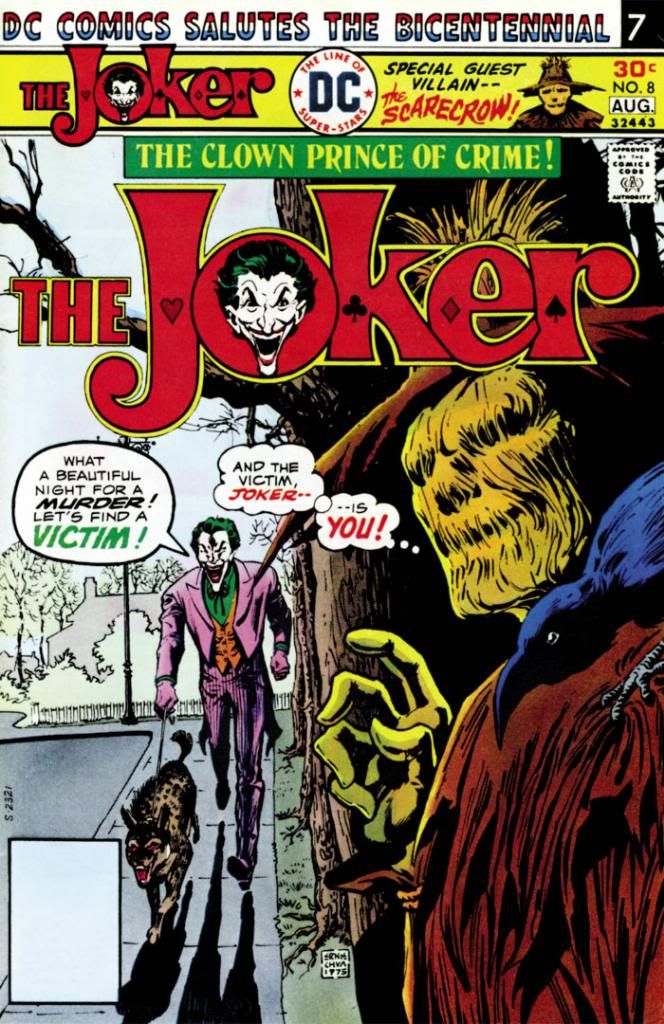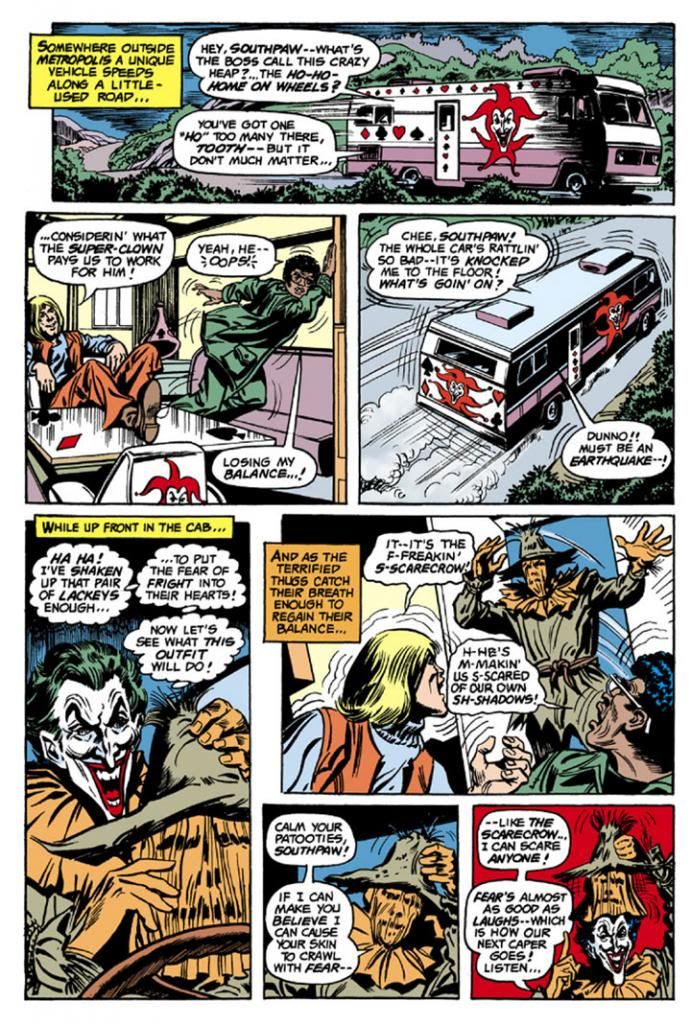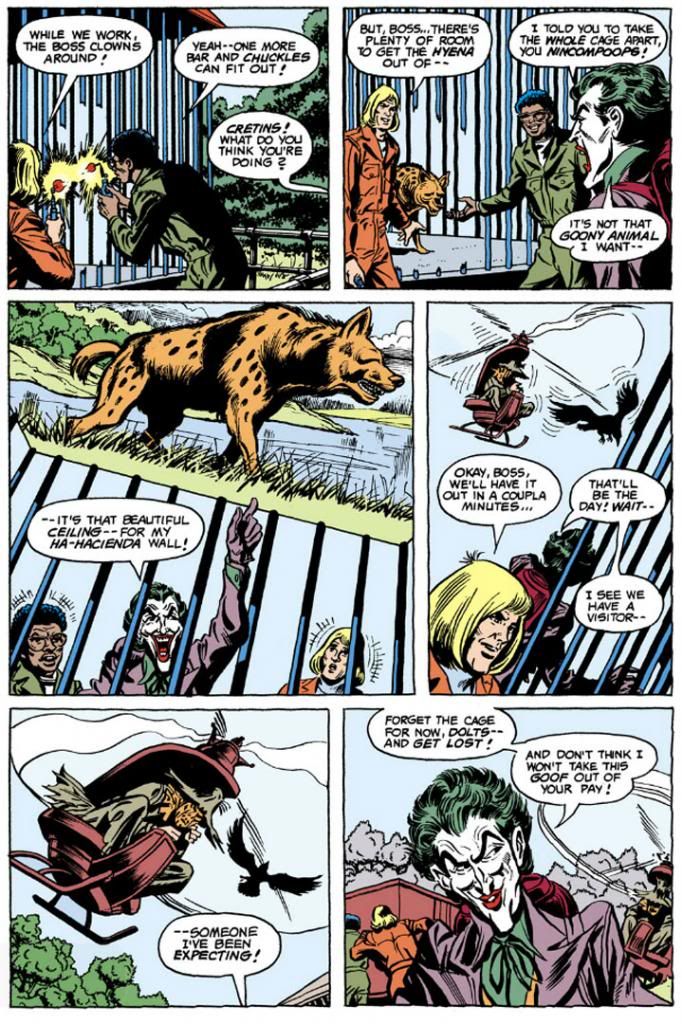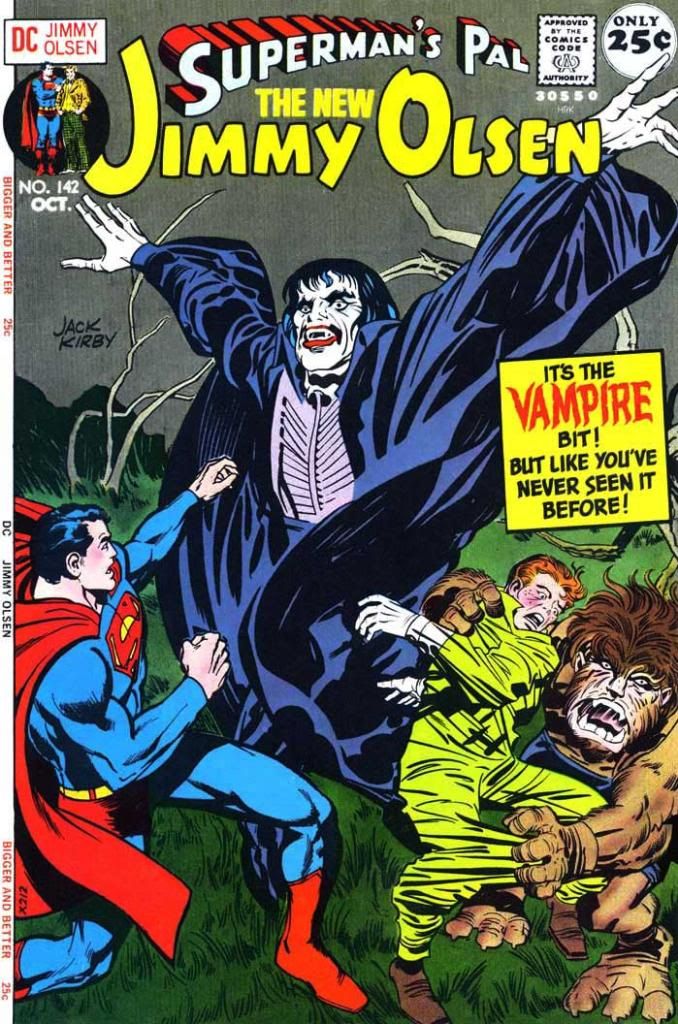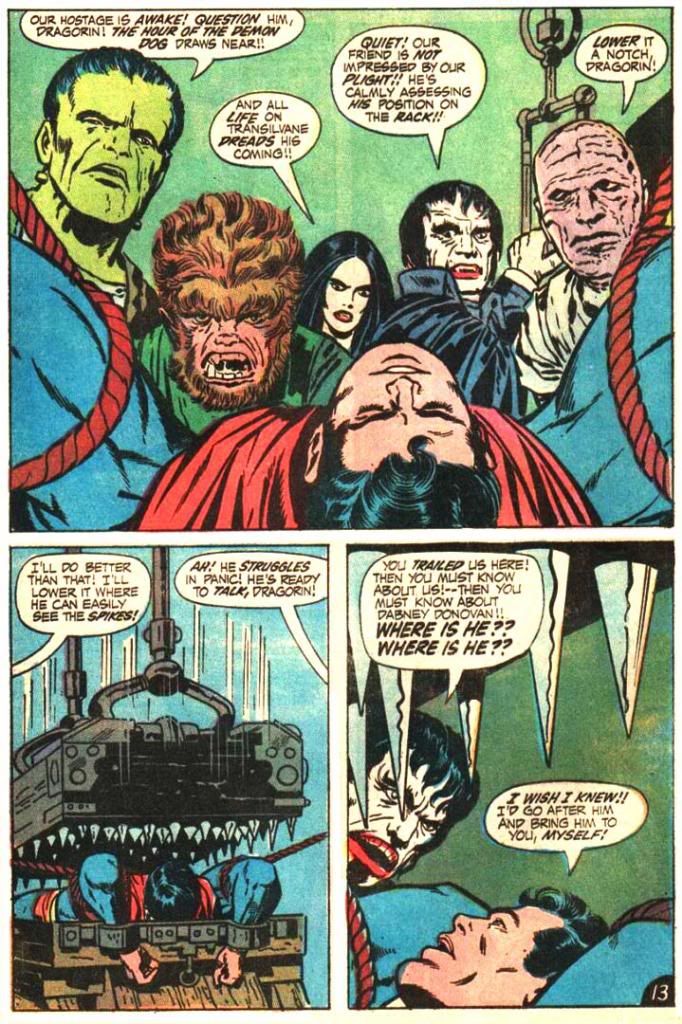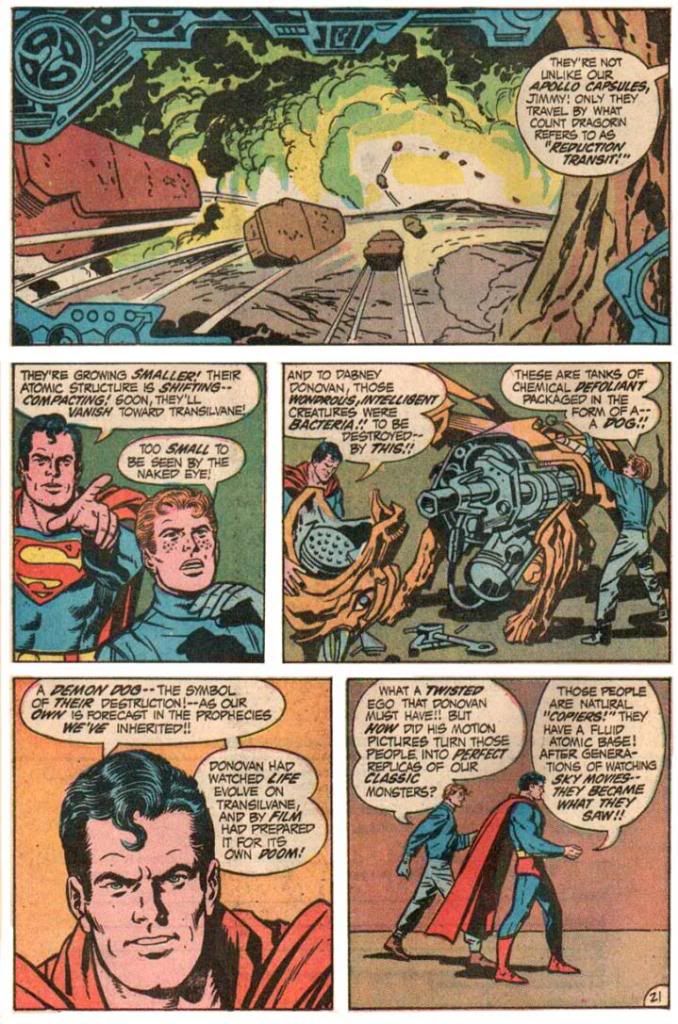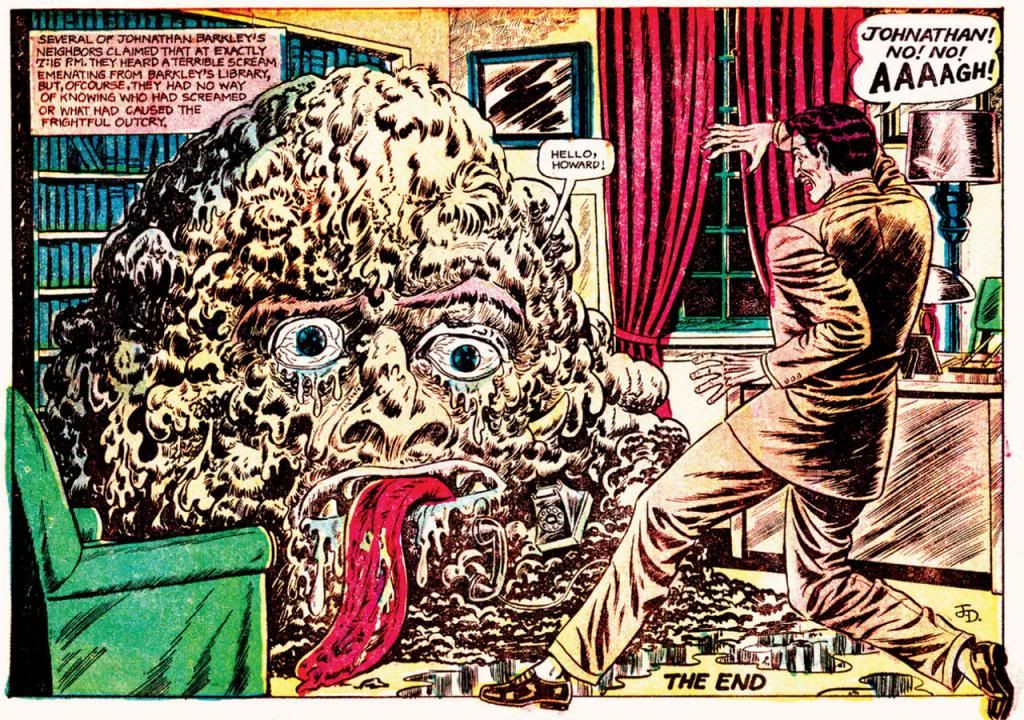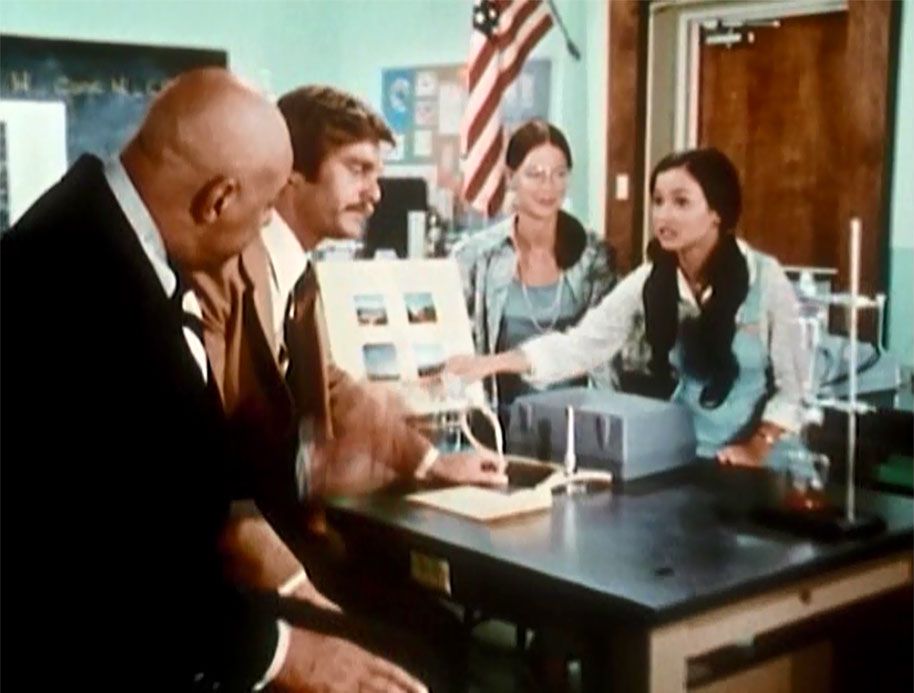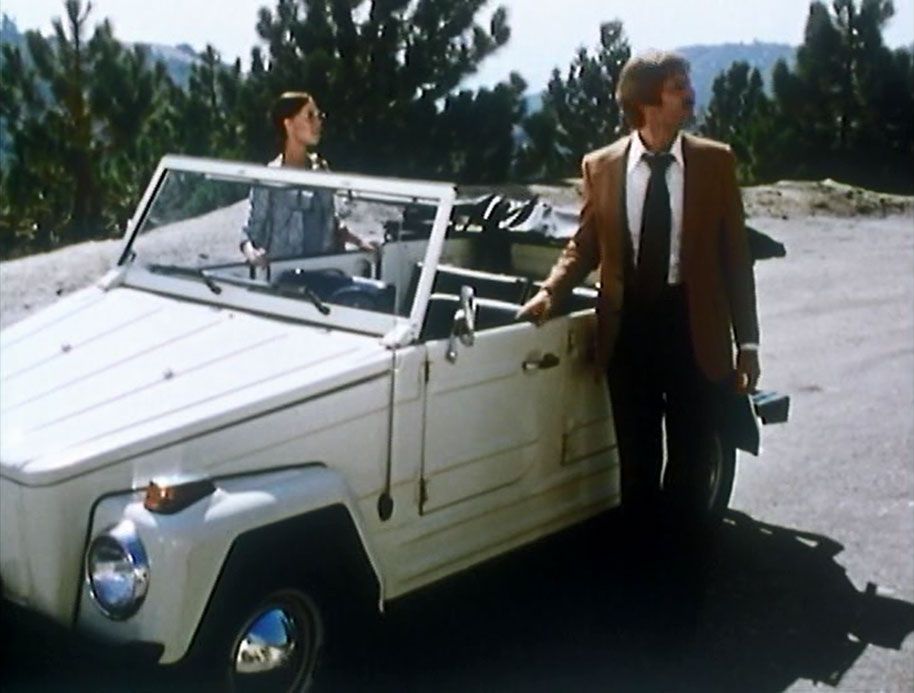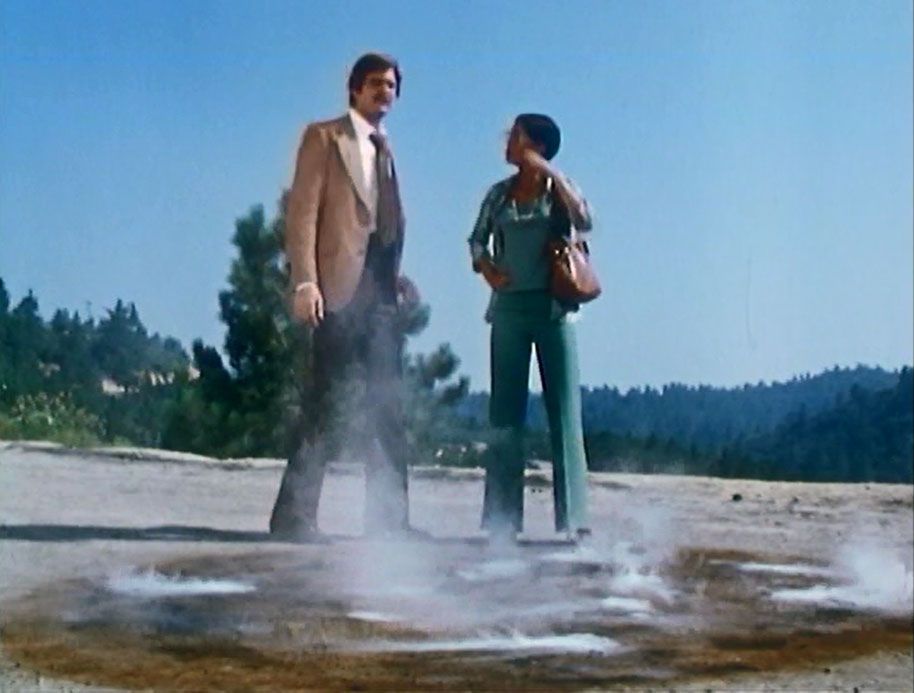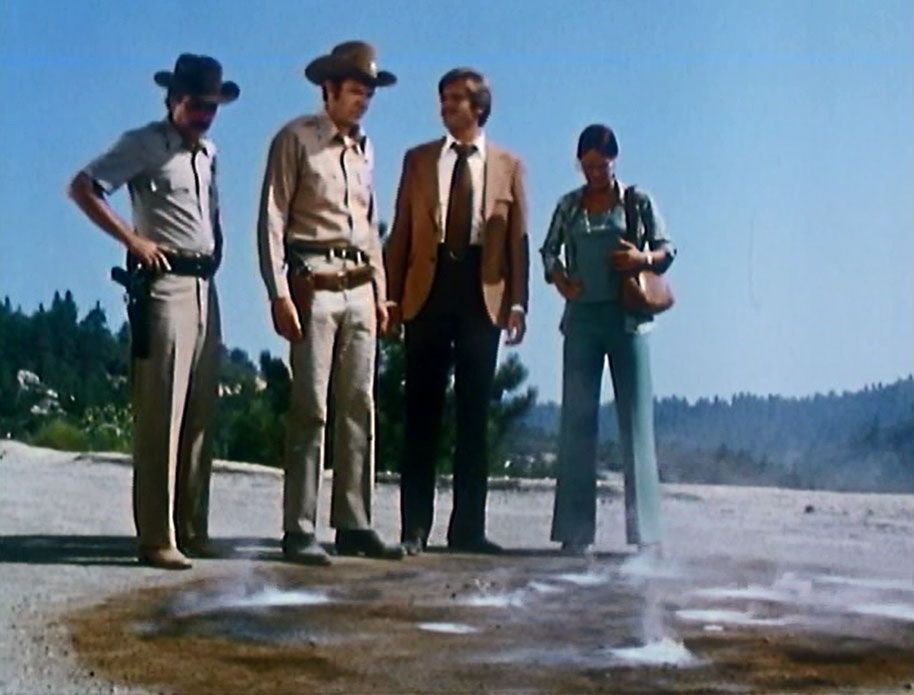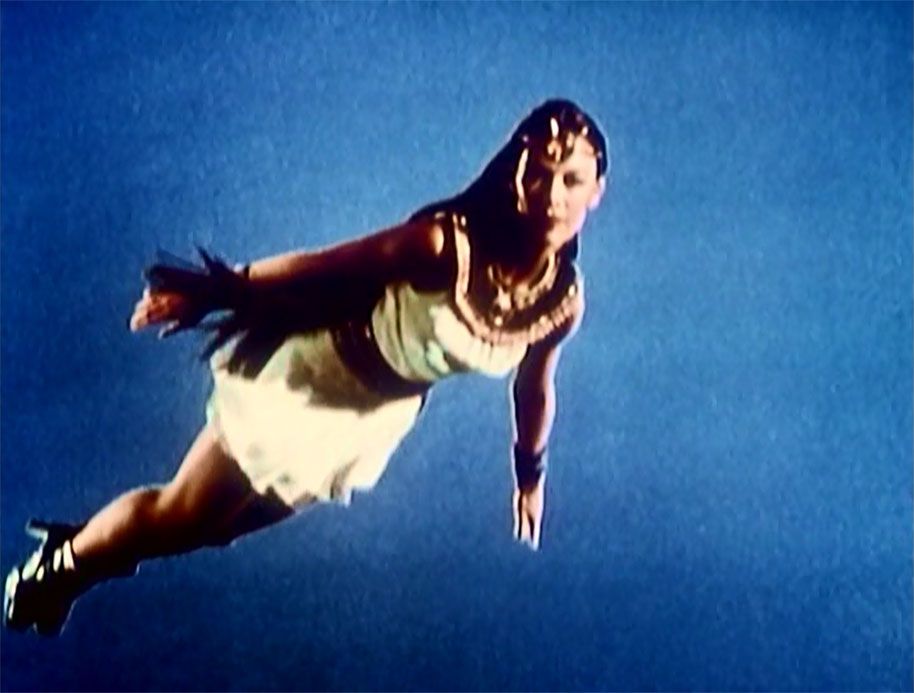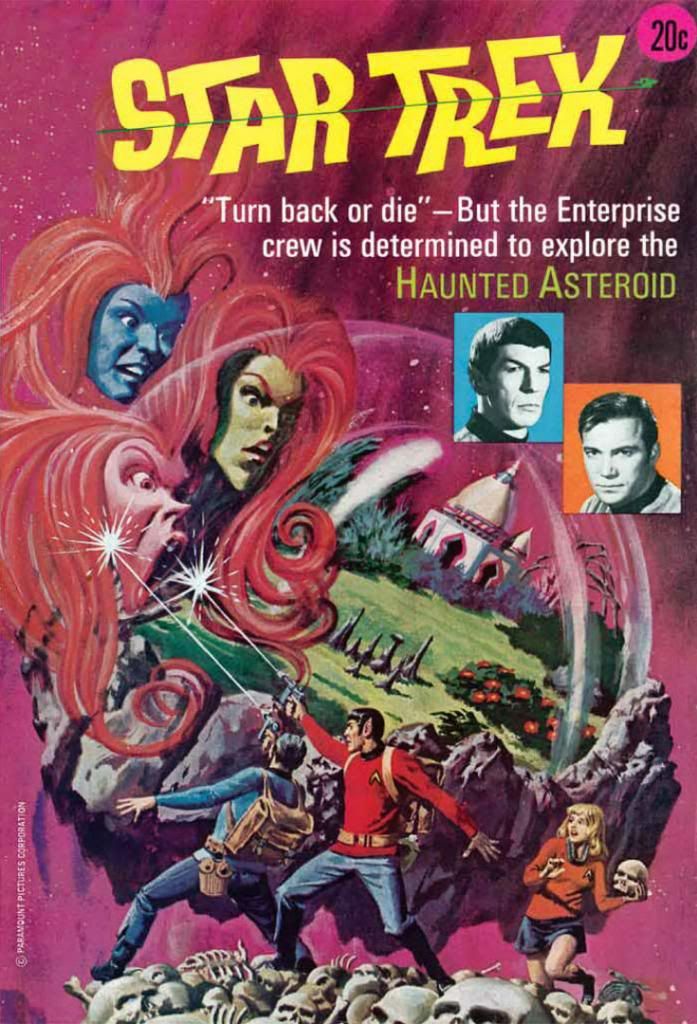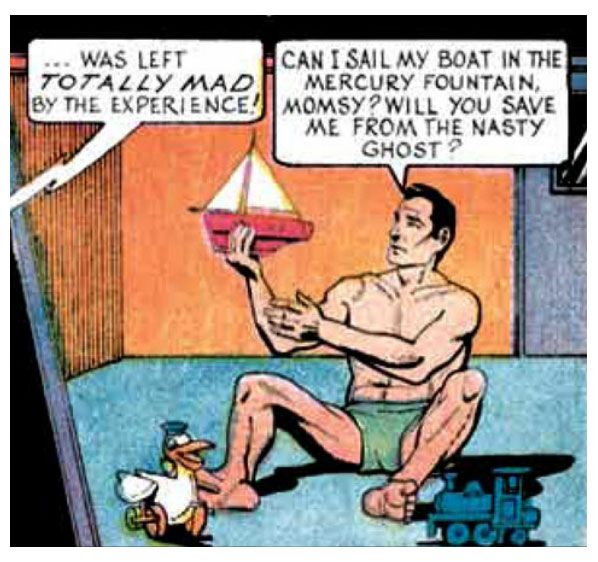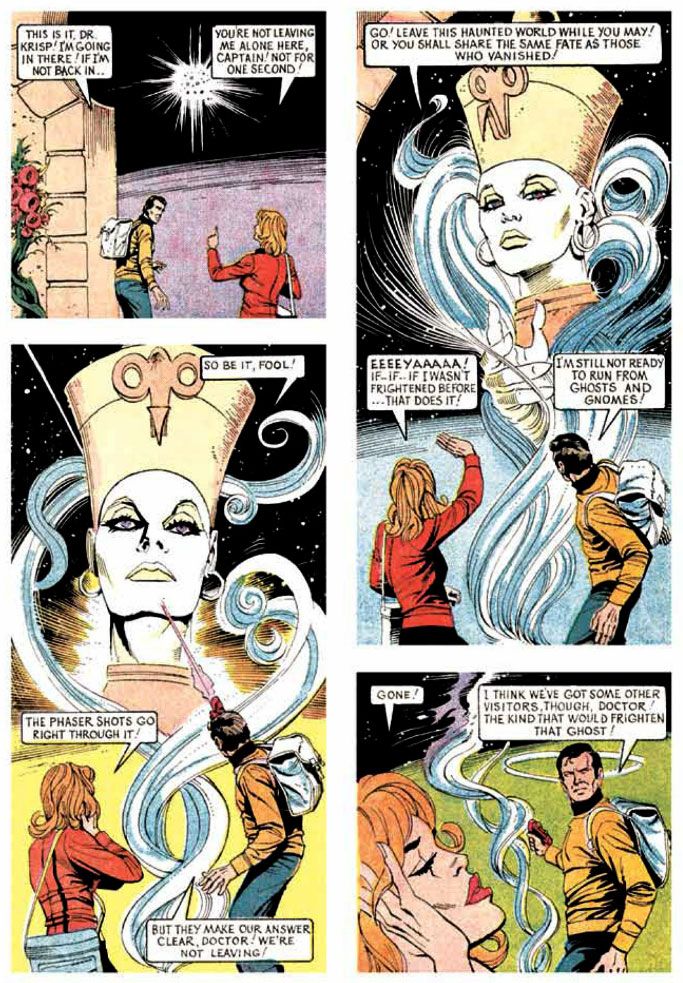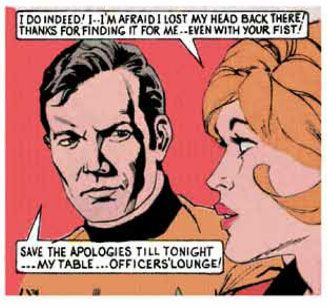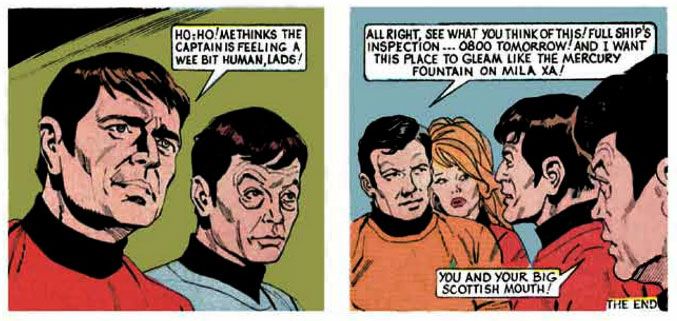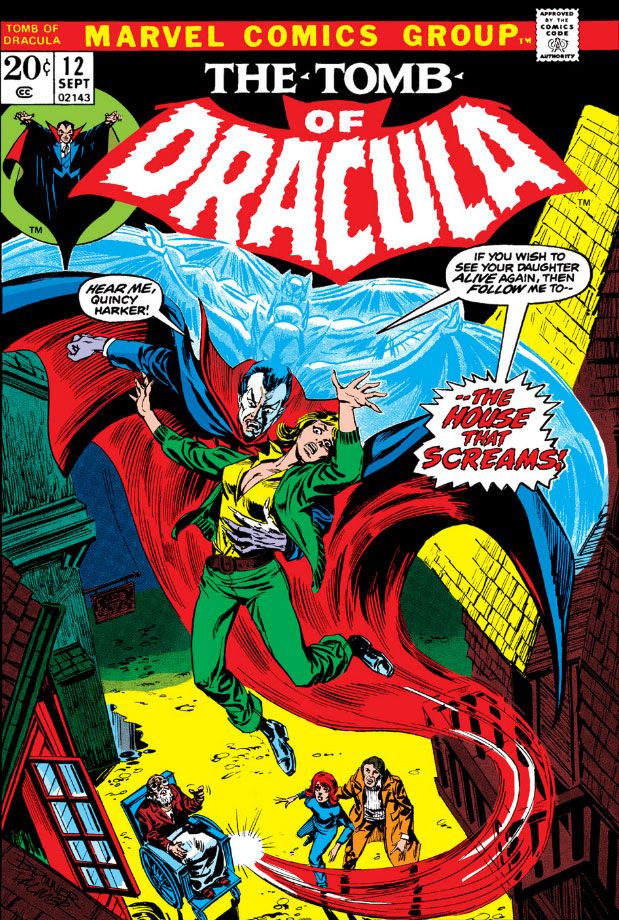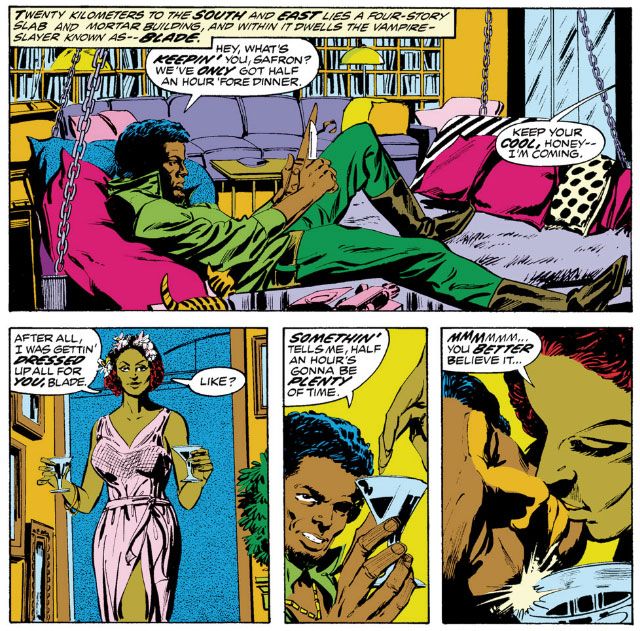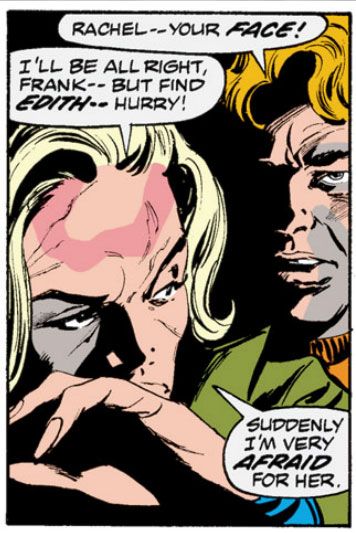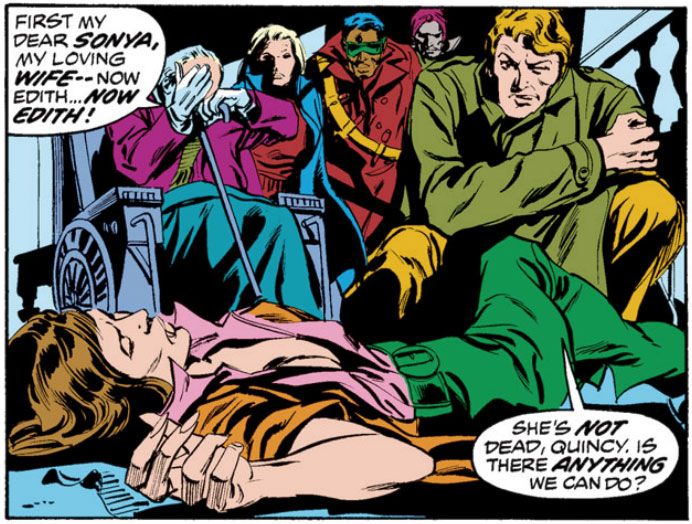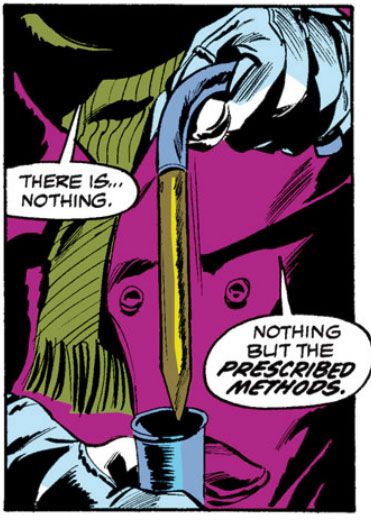If there's a DC super-villain made for Halloween, it must be the Scarecrow. He likes to scare people, people like to be scared on Halloween. The Joker #8 (August 1976) pits him against our titular anti-hero over a batch of new-fangled fear gas developed by those happy-go-lucky chemical warfare specialists down at S.T.A.R. Laboratories. What's startling about this book is despite its sunnily appealing Irv Novick-Tex Blaisdell art, there's a body count. I'm simply fascinated by this dichotomy, which gives the book a mood of joyful nihilism. Innocent people die, and so does a not-so-innocent. The Joker himself says it best right there on the cover, "What a beautiful night for a murder. Let's find a victim!"
While we're looking at it, that's a nice Ernie Chan cover. Once again, Chan had to sign it "Chua," thanks to some kind of bureaucratic goof involving his work visa. Whoever colored it didn't quite capture the essence of night, though. No matter. The lurking Scarecrow provides a lot of menace that's missing in the cheerful story itself. I mean despite all the killing.
And now a special message to you, the reader!
Dear Reader,
How have you been? Did you have a nice summer?
Okay, let's discuss something perhaps you can help me with. This story brings up something that's troubled me for a long time. I just can't imagine why your average, ordinary, work-a-day criminal would ever join the Joker's gang.
Being a Joker henchperson has such a high fatality rate. One touch you can almost count on in any Joker story is when the writer decides to present the Joker's bona fides as a dangerous lunatic by having him off a henchman. This time writer Eliot S. Maggin floats the clever idea the Joker instills a post-hypnotic killing suggestion in all his employees. If any of his gang rats him out, that person laughs himself or herself to death. Good deal for the Joker, but a terrible burden for his lackeys.
While there's no riskier occupation in the DC universe than Joker henchperson, there is virtually no reward in it. Most of us grow up with the idea of risk versus reward. The greater the risk, the greater the expected reward. What's the reward for members of a Joker gang? Even if the Joker decides to steal, say, a solid gold statue of famous clown Emmett Kelly, he's not doing it to melt the metal down and sell it off and split the profit equitably, or even to remove it from the market in hopes of increasing the value of his own stockpile (although a single statue would hardly do that) as when Auric Goldfinger colluded with communist China to irradiate the United States' gold reserves at Fort Knox. The Joker operates whimsically. He steals that statue because Emmett Kelly appeals to him in some personal way and he just wants to look at it. In this story, the Joker takes the fear gas so he can use it to steal the ceiling out of a hyena cage because the painting on it would make a pretty decoration for his "Ha-Hacienda," a kind of Winnebago of crime he and his gang drive around in.
Yet the Joker never seems to lack for lackeys, does he? It's easy to understand why the Joker would appeal to anarchists, weirdos, cultists and anti-social types. Even Charles Manson has fans. But as far as I know, no writer has attempted to explain the attraction of working for the Joker to the Rockos and Leftys out there in Gotham City and Metropolis. The blue-collar professionals-- safe-crackers, strong-arms, grifters, B&E boys (and girls) and car-thieves-- with families to feed.
Here's where you come in, loyal reader. Has any DC writer addressed this in a story? I know Alan Moore had the Joker employ carnival freaks in Killing Joke-- which makes a lot of sense-- but never explained their motivation for taking part in his spree. Every other Joker story I can think of features more conventional criminal types. What's their attraction to the Joker? I can only conclude lawbreakers in the DC universe must be even bigger idiots than real-world criminals.
Thanking you in advance!
Sincerely,
A Dope
Oh yeah! I forgot all about the Scarecrow!
He flies into the comic in a teensy-tiny helicopter with his knees jutting skyward as if he's Disney's Ichabod Crane (a partial inspiration, I believe) on his horse at the end of the classic The Legend of Sleepy Hollow segment from their 1949 package film The Adventures of Ichabod and Mr. Toad. He and the Joker engage in a duel right there in the zoo, and Scarecrow makes a complete ass of himself. Oh well, to hell with him. Here's Der Bingle singing about the Headless Horseman...
Here's Thurl Ravenscroft doing the same...
Happy Halloween, everyone!
Wednesday, October 30, 2013
Tuesday, October 29, 2013
October is Spookey Month: Jack Kirby pits Jimmy Olsen and his pal, Superman, against a vampire. The winner? Anyone who reads it!
Jack Kirby drew comics in just about every genre. Which is a pretty conservative way of putting it when you consider he actually invented or co-invented some of them. As a Kirby fanatic, I wanted to link him to my annual Halloween celebration here, and rather than talk about Spirit World (Kirby does the paranormal) or some of his straight-up horror work (you can find it scattered about in various reprints, Archives, Essentials and Showcases and IDW's Haunted Horror), I have decided to once again explore his early-70s DC years. We love those book here.
In Superman's Pal Jimmy Olsen #142 and #143 (October-November 1971), Kirby gives the then-corny vampire routine a science-fiction/superhero twist. Nowadays we have scary vampires again, and romantic, sparkling vampires and vampires that fight werewolves with Matrix-style kung-fu, but when Kirby wrote this story, movie vampires were pretty much still tuxedo-wearing noblemen and the occasional lesbian baroness in a Victorian-style negligee. Comics in particular had worn out the theme, despite years of a Comics Code ban on vampires. Once EC had modern-day vampires put taps in their victims' necks and Warren saw an old school county-style vampire take a spaceship to a planet of perpetual night, the concept had been stretched past recognition, like Dick Tracy's face imprinted on Silly Putty (I used to love distorting that guy). The only things left were parody and deconstruction. Kirby's story tends towards the latter, although the self-aware cover copy hints at the former.
That's as close to tongue-in-cheek as this story gets. The rest of it is as sincere as Linus' pumpkin patch in It's the Great Pumpkin, Charlie Brown. Kirby expends a lot of energy here trying to make readers buy this concept and he's not playing around or being cutesy.
Count Dragorin, the man from Transilvane, does everything you've come to expect from a vampire, up to and including having a werewolf as a best friend. Kirby wastes no time kickstarting the plot as Dragorin and his beastly companion slip into the city one night and put the bite on a sleeping receptionist by the name of Laura Conway. Kirby's updated answer to the age-old vampiric transformation scene is to have Dragorin accomplish this via some kind of twin yellow power emanations from his eyes. They leave the tradition double bite mark on the receptionist's neck and "change her body chemistry." Within a couple of pages we have Clark Kent and Jimmy Olsen fighting Dragorin for Laura Conway's soul-- or at least her free will-- right there in broad daylight inside the GBS (Galaxy Broadcasting System) offices. Dragorin is after a former NASA scientist named Dabney Donovan, and Conway was once Donovan's personal secretary. Intercut with this is a subplot with the Newsboy Legion trying to escape from the Cadmus Project (they're not prisoners; their fathers work there and they're just up to their usual independent-minded mischief), so these are some really busy issues.
When Superman and Jimmy Olsen track down the scientist's lab (beneath a mausoleum in the pleasantly-named Bloodmoor Cemetery), they find they're not dealing only with a vampire and werewolf couple. There are all kinds of familiar creatures. So what does Kirby do to explain these Space Age vampires, werewolves and the like within the science fiction setting? Well, it turns out Dragorin and company are microscopic aliens from an artificial planet. That floats inside a room that looks like a creepy castle set where James Whale would have put Boris Karloff through his paces, or Todd Browning would have put Bela Lugosi through his. And if that wasn't enough, the aliens on that world have developed a society based on old horror movies as well thanks to the bizarre experiments of Dr. Donovan, who must be a real piece of work himself.
For some reason known but to himself (and, I think, NASA), Donovan didn't just make a world. He also chose those horror movies from his vast personal collection of films and projected them into its clouds. The sentient life there turns out to have remarkable adaptive and imitative properties, kind of like those gangster guys and the Nazis the Star Trek crew dealt with on their old TV show. Some of the people there turned into vampires, some into Frankenstein's monsters and others into mummies and werewolves. They travel from their planet to ours by riding inside coffins that grow or shrink depending on which way they're transiting.
Kirby doesn't really bother to explain Donovan's scientific motivation. After all, what could he have hoped to gain from such an experiment? Certainly if he had published his results, the idea that we as a species could create an entire miniature world full of intelligent, evolving life, would result in a philosophical or even a religious sea change. But Donovan seems to have added these rather baroque flourishes for his own personal enjoyment, and then to destroy via a robotic dog filled with a chemical defoliant.
The horror and science fiction aspects create a dissonance that's fun but, like Frankenstein's monster, reveal some of the stitching Jack Kirby did to make the story work. Because Kirby's trying to assemble this creature in a way that gives it life and makes sense, some of the details are a bit too on-the-nose-- the space coffins compared to the Apollo re-entry process, for example-- while others remain shadowy, as if they're inexplicable. Why did Donovan use old horror movies in the first place? And we not only never meet the nutty scientist who did this, but he never receives a comeuppance for what amounts to attempted genocide.
I love that after all this oversized craziness-- even if it's also about miniature creatures as well-- Kirby chooses to end it on a minor note, with two pals sitting down together to watch Oklahoma! It's just so human. They're not even nonplussed about letting Donovan get away scot free, or having encountered human-created sentient life that could potentially affect life on earth in horrific ways, like some kind of virus escaping from a weapons lab.
But maybe Superman is completely aware of this and downplaying it for Jimmy's sake as he renders the Transilvanians harmless in his own inimitable way. From what I've read, writers and artists later extended the Transilvane concept and finally had Donovan make a story appearance as a full-blown villain, but a true sequel to this story would have Dragorin and friends transformed into good-natured cowboys and farm girls, and singing about a surrey with a fringe on top.
Oh, and be sure to note the Superman figure on the cover to #142. Neal Adams re-touch. And check out all the Al Plastino faces in the interior art. Occasionally some Kirby comes through, but I really wish DC hadn't felt the need to do this.
In Superman's Pal Jimmy Olsen #142 and #143 (October-November 1971), Kirby gives the then-corny vampire routine a science-fiction/superhero twist. Nowadays we have scary vampires again, and romantic, sparkling vampires and vampires that fight werewolves with Matrix-style kung-fu, but when Kirby wrote this story, movie vampires were pretty much still tuxedo-wearing noblemen and the occasional lesbian baroness in a Victorian-style negligee. Comics in particular had worn out the theme, despite years of a Comics Code ban on vampires. Once EC had modern-day vampires put taps in their victims' necks and Warren saw an old school county-style vampire take a spaceship to a planet of perpetual night, the concept had been stretched past recognition, like Dick Tracy's face imprinted on Silly Putty (I used to love distorting that guy). The only things left were parody and deconstruction. Kirby's story tends towards the latter, although the self-aware cover copy hints at the former.
That's as close to tongue-in-cheek as this story gets. The rest of it is as sincere as Linus' pumpkin patch in It's the Great Pumpkin, Charlie Brown. Kirby expends a lot of energy here trying to make readers buy this concept and he's not playing around or being cutesy.
Count Dragorin, the man from Transilvane, does everything you've come to expect from a vampire, up to and including having a werewolf as a best friend. Kirby wastes no time kickstarting the plot as Dragorin and his beastly companion slip into the city one night and put the bite on a sleeping receptionist by the name of Laura Conway. Kirby's updated answer to the age-old vampiric transformation scene is to have Dragorin accomplish this via some kind of twin yellow power emanations from his eyes. They leave the tradition double bite mark on the receptionist's neck and "change her body chemistry." Within a couple of pages we have Clark Kent and Jimmy Olsen fighting Dragorin for Laura Conway's soul-- or at least her free will-- right there in broad daylight inside the GBS (Galaxy Broadcasting System) offices. Dragorin is after a former NASA scientist named Dabney Donovan, and Conway was once Donovan's personal secretary. Intercut with this is a subplot with the Newsboy Legion trying to escape from the Cadmus Project (they're not prisoners; their fathers work there and they're just up to their usual independent-minded mischief), so these are some really busy issues.
When Superman and Jimmy Olsen track down the scientist's lab (beneath a mausoleum in the pleasantly-named Bloodmoor Cemetery), they find they're not dealing only with a vampire and werewolf couple. There are all kinds of familiar creatures. So what does Kirby do to explain these Space Age vampires, werewolves and the like within the science fiction setting? Well, it turns out Dragorin and company are microscopic aliens from an artificial planet. That floats inside a room that looks like a creepy castle set where James Whale would have put Boris Karloff through his paces, or Todd Browning would have put Bela Lugosi through his. And if that wasn't enough, the aliens on that world have developed a society based on old horror movies as well thanks to the bizarre experiments of Dr. Donovan, who must be a real piece of work himself.
For some reason known but to himself (and, I think, NASA), Donovan didn't just make a world. He also chose those horror movies from his vast personal collection of films and projected them into its clouds. The sentient life there turns out to have remarkable adaptive and imitative properties, kind of like those gangster guys and the Nazis the Star Trek crew dealt with on their old TV show. Some of the people there turned into vampires, some into Frankenstein's monsters and others into mummies and werewolves. They travel from their planet to ours by riding inside coffins that grow or shrink depending on which way they're transiting.
Kirby doesn't really bother to explain Donovan's scientific motivation. After all, what could he have hoped to gain from such an experiment? Certainly if he had published his results, the idea that we as a species could create an entire miniature world full of intelligent, evolving life, would result in a philosophical or even a religious sea change. But Donovan seems to have added these rather baroque flourishes for his own personal enjoyment, and then to destroy via a robotic dog filled with a chemical defoliant.
The horror and science fiction aspects create a dissonance that's fun but, like Frankenstein's monster, reveal some of the stitching Jack Kirby did to make the story work. Because Kirby's trying to assemble this creature in a way that gives it life and makes sense, some of the details are a bit too on-the-nose-- the space coffins compared to the Apollo re-entry process, for example-- while others remain shadowy, as if they're inexplicable. Why did Donovan use old horror movies in the first place? And we not only never meet the nutty scientist who did this, but he never receives a comeuppance for what amounts to attempted genocide.
I love that after all this oversized craziness-- even if it's also about miniature creatures as well-- Kirby chooses to end it on a minor note, with two pals sitting down together to watch Oklahoma! It's just so human. They're not even nonplussed about letting Donovan get away scot free, or having encountered human-created sentient life that could potentially affect life on earth in horrific ways, like some kind of virus escaping from a weapons lab.
But maybe Superman is completely aware of this and downplaying it for Jimmy's sake as he renders the Transilvanians harmless in his own inimitable way. From what I've read, writers and artists later extended the Transilvane concept and finally had Donovan make a story appearance as a full-blown villain, but a true sequel to this story would have Dragorin and friends transformed into good-natured cowboys and farm girls, and singing about a surrey with a fringe on top.
Oh, and be sure to note the Superman figure on the cover to #142. Neal Adams re-touch. And check out all the Al Plastino faces in the interior art. Occasionally some Kirby comes through, but I really wish DC hadn't felt the need to do this.
Saturday, October 26, 2013
October is Still Spookey Month: Sugar and Spike's Halloween-themed covers!
These are pure joy. I really don't have anything to say about any particular cover in this collection, so we'll let Sheldon Mayer's work speak for itself and fill you with the spooky, fun Halloween spirit.
There! I'm ready to go trick or treating and it's only October 27th. I've only read one or two Sugar and Spike stories, but the Comic Book Artist #11 (January 2001) flip side devoted to Mayer and his kids made me a believer. I wish DC and Comixology would make this entire series available so I could put up some better scans instead of ones I had to scour the web to find and then clean up a little for you. I did as good a job as time (little) and money (zero) would allow and it's our good fortune Sugar and Spike fans put them out there for all of us to enjoy.
And now you also enjoy my favorite Spookey video!
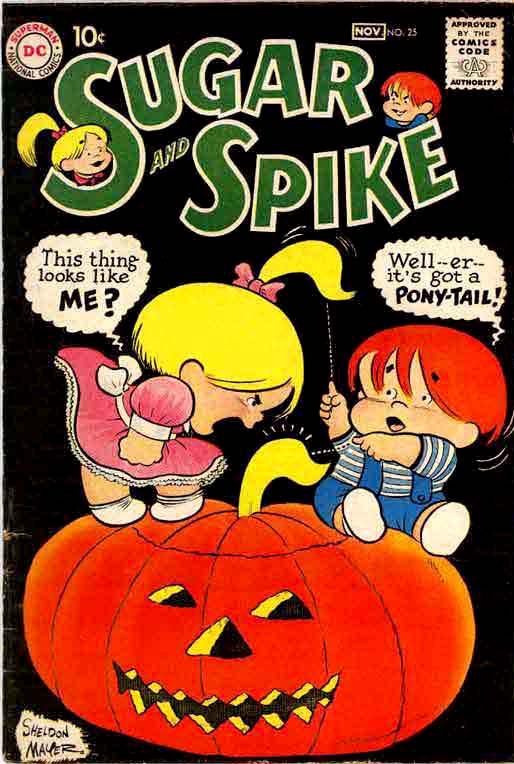 | ||
| Sugar and Spike #25 (Oct.-Nov. 1959) |
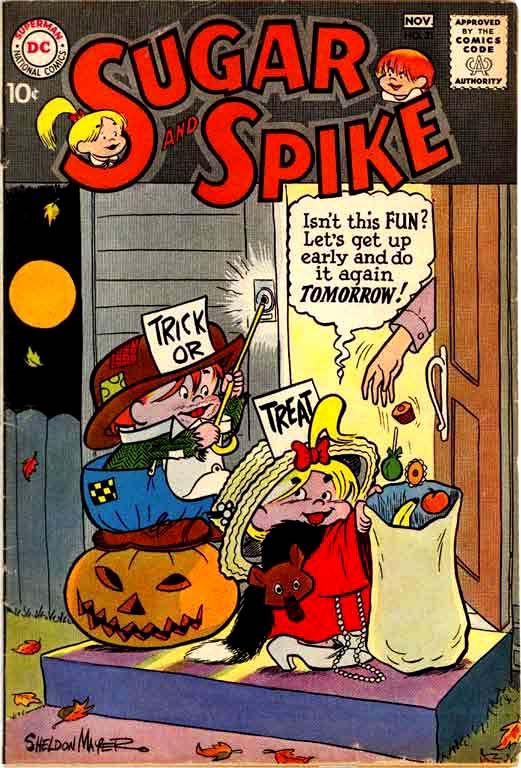 |
| Sugar and Spike #31 (Oct.-Nov. 1960) |
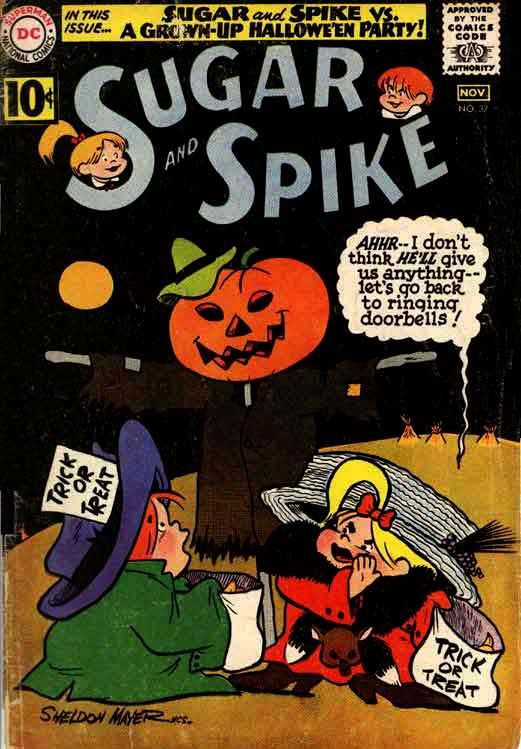 |
| Sugar and Spike #37 (Oct.-Nov. 1961) |
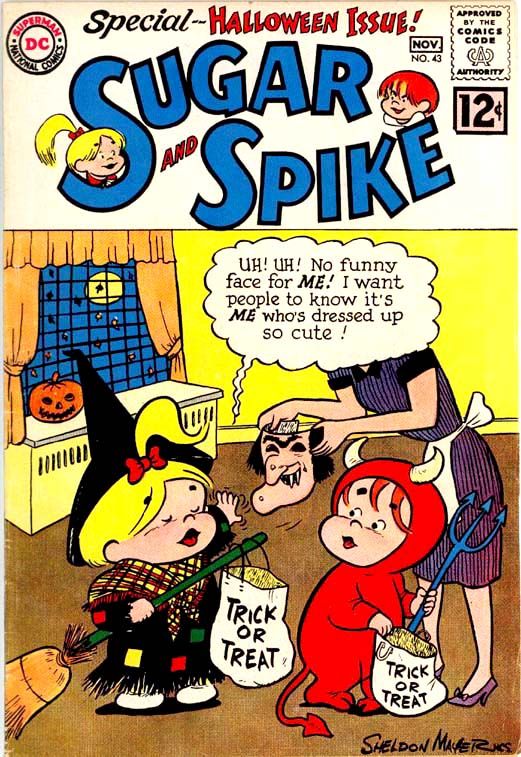 |
| Sugar and Spike #43 (Oct.-Nov. 1962) |
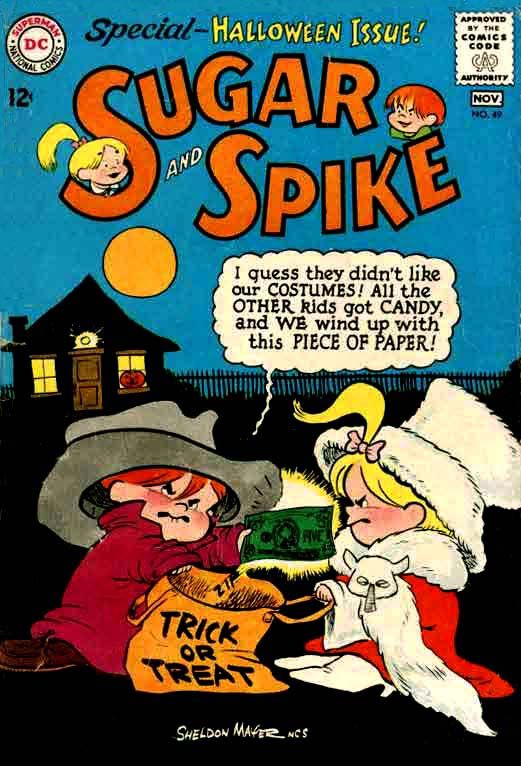 |
| Sugar and Spike #49 (Oct.-Nov. 1963) |
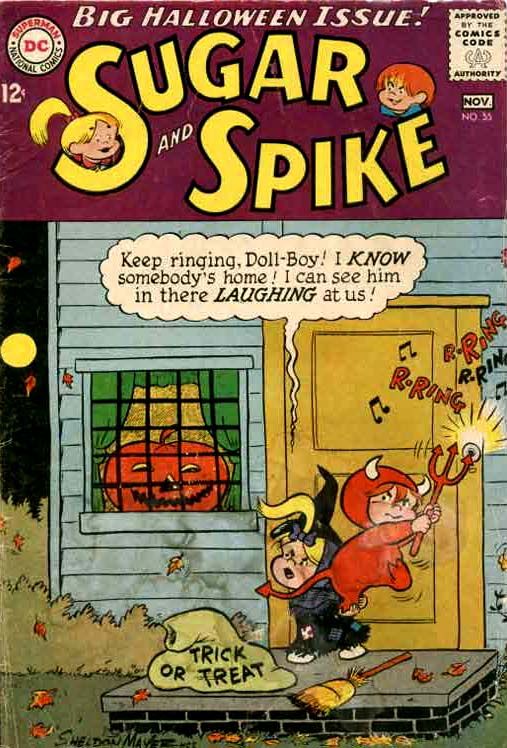 |
| Sugar and Spike #55 (Oct.-Nov. 1964) |
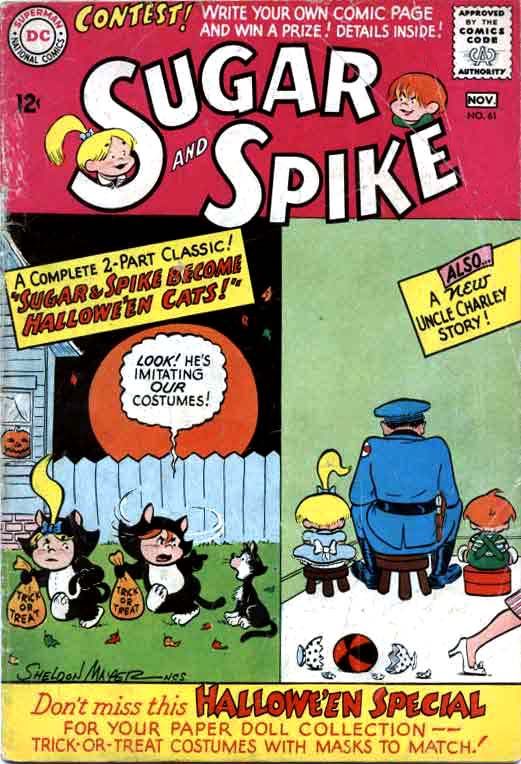 |
| Sugar and Spike #61 (Oct.-Nov. 1965) |
 |
| Sugar and Spike #67 (Oct.-Nov. 1966) |
There! I'm ready to go trick or treating and it's only October 27th. I've only read one or two Sugar and Spike stories, but the Comic Book Artist #11 (January 2001) flip side devoted to Mayer and his kids made me a believer. I wish DC and Comixology would make this entire series available so I could put up some better scans instead of ones I had to scour the web to find and then clean up a little for you. I did as good a job as time (little) and money (zero) would allow and it's our good fortune Sugar and Spike fans put them out there for all of us to enjoy.
And now you also enjoy my favorite Spookey video!
Labels:
DC Comics,
good art,
Halloween,
Sheldon Mayer,
Spookey,
Sugar and Spike,
vintage comics
Wednesday, October 23, 2013
October is Spookey Month: Haunted Horror, in which you can find 1950s pre-Code horror that's sometimes disgusting
A comic book Halloween wouldn't be complete without a few 1950s fear-fests. Man, those Fifties cats really knew how to horror things up, how to jive and jazz and wail! Then the Comics Code came and the music stopped. For a while. The jam moved over to the Warren black and white mags but full-color monthly comics ended up stunted. By time I was a comic book-reading kid, we had a few cool DC anthology series, but the granddaddy of them all was simply a legend. I'm talking EC. You could order expensive hardcover, slip-cased reprints, but those were for the old guys with their disposable income, brandy snifters and smoking jackets. It wasn't until Russ Cochran and Gladstone Publishing started reprinting Tales from the Crypt, Vault of Horror and The Haunt of Fear and selling them through newsstands that I was finally able to read those fabled classics in color.
But I soon learned EC wasn't the only publisher doing sick horror in the 50s. You know how it went with comics back then-- if something proved a money-maker, everyone in the business flooded the market with their own versions. Heck, I don't even know who published the original horror hit. EC just did it best, and they're the ones who took the blame when Uncle Sam cracked down on too much of a good thing. Those other publishers doing the EC thang back in the day interested me greatly because of my appetite for pre-Code horror, but those remained fleeting phantoms that haunted the periphery of the whole tragic tale. Until now.
IDW's Yoe Comics packages this book they call Haunted Horror where you can find stories from a lot of those non-EC guys. I just bought a bunch of them on Comixology (.99!), and I'm loving them. Some of them feature art by recognizable names-- the Iger Shop, Joe Simon and Jack Kirby (Whatever happened to him? He showed real promise!), Jack Cole and a guy by the name of Ditko who later did some kind of bug-related hero the kids seemed to like. Some of them are just crude and weird and even a little off-putting at times. But yeah, I'm loving all of them.
It's just...
Every so often if you read enough horror comics, you will run into an image that just burns through your eyeballs into your brain, charring part of it and pretty much leaving you a shambling wreck. A lumbering zombie, if you will. And so I will now present one of those...
EEK!! It's Jay Disbrow's version of Mel Brooks' Pizza the Hutt, only 33 years early.
The long tongue is an especially nice detail. To add a little context, the guy screaming is the blob's doctor. Or he was, when the blob was a man. If you'll look closely-- dare it-- you'll see a rotary-dial telephone kind of sloughing off the blob's side. The doctor came in response to a call from that very phone, and if you're puzzling out how something like this mass of what appears to be melted flesh could manage to spin that old-fashioned dial, I refer you back to the tongue.
I wonder how many kids saw this story when it was first printed. Thousands? If so, those were some lucky kids, but I doubt their parents appreciated the loss of appetite that no doubt accompanied the reading of this story. Right about dinnertime, across America, little people with coonskin caps and skinned knees turned up their collective noses at Mom's radar-ranged glazed ham and peas and carrots, then got the spankings of a lifetime when they refused to eat. They were incapable. I read this three days ago and I haven't eaten so much as a crumb or speck of food.*
That's what a good horror comic should do for you. Put you off your feed. Junji Ito's Uzumaki is a more recent example of a horror comic that turned my stomach. Another old one is the story "Tight Grip!" illustrated by Jack Davis. In that one, a murderer stupidly hides inside the sentient trunk belonging to his victim and it compresses him. His meaty parts stream out in thin ribbons through bullet holes he shoots in the trunk and investigators find nothing inside the tiny trunk but a cube of powdered bone. Grotesque. Gives me a chill just thinking about it. "Tight Grip!" ran in EC's Tales From the Crypt #38 (October-November 1953) and you can read it today in the Fantagraphics volume devoted to Davis' horror work, 'Taint the Meat... It's the Humanity!
And now we have Disbrow's blob.
Anyway, a big thanks to Craig Yoe, Steve Banes, Clizia Gussoni and all the people at Yoe! Studio and IDW for putting all this effort into putting these stories back into print and broadening my experience of 1950s horror comics. And also making me sick.
*A blatant lie. I've been making a pig of myself.
But I soon learned EC wasn't the only publisher doing sick horror in the 50s. You know how it went with comics back then-- if something proved a money-maker, everyone in the business flooded the market with their own versions. Heck, I don't even know who published the original horror hit. EC just did it best, and they're the ones who took the blame when Uncle Sam cracked down on too much of a good thing. Those other publishers doing the EC thang back in the day interested me greatly because of my appetite for pre-Code horror, but those remained fleeting phantoms that haunted the periphery of the whole tragic tale. Until now.
IDW's Yoe Comics packages this book they call Haunted Horror where you can find stories from a lot of those non-EC guys. I just bought a bunch of them on Comixology (.99!), and I'm loving them. Some of them feature art by recognizable names-- the Iger Shop, Joe Simon and Jack Kirby (Whatever happened to him? He showed real promise!), Jack Cole and a guy by the name of Ditko who later did some kind of bug-related hero the kids seemed to like. Some of them are just crude and weird and even a little off-putting at times. But yeah, I'm loving all of them.
It's just...
Every so often if you read enough horror comics, you will run into an image that just burns through your eyeballs into your brain, charring part of it and pretty much leaving you a shambling wreck. A lumbering zombie, if you will. And so I will now present one of those...
EEK!! It's Jay Disbrow's version of Mel Brooks' Pizza the Hutt, only 33 years early.
The long tongue is an especially nice detail. To add a little context, the guy screaming is the blob's doctor. Or he was, when the blob was a man. If you'll look closely-- dare it-- you'll see a rotary-dial telephone kind of sloughing off the blob's side. The doctor came in response to a call from that very phone, and if you're puzzling out how something like this mass of what appears to be melted flesh could manage to spin that old-fashioned dial, I refer you back to the tongue.
I wonder how many kids saw this story when it was first printed. Thousands? If so, those were some lucky kids, but I doubt their parents appreciated the loss of appetite that no doubt accompanied the reading of this story. Right about dinnertime, across America, little people with coonskin caps and skinned knees turned up their collective noses at Mom's radar-ranged glazed ham and peas and carrots, then got the spankings of a lifetime when they refused to eat. They were incapable. I read this three days ago and I haven't eaten so much as a crumb or speck of food.*
That's what a good horror comic should do for you. Put you off your feed. Junji Ito's Uzumaki is a more recent example of a horror comic that turned my stomach. Another old one is the story "Tight Grip!" illustrated by Jack Davis. In that one, a murderer stupidly hides inside the sentient trunk belonging to his victim and it compresses him. His meaty parts stream out in thin ribbons through bullet holes he shoots in the trunk and investigators find nothing inside the tiny trunk but a cube of powdered bone. Grotesque. Gives me a chill just thinking about it. "Tight Grip!" ran in EC's Tales From the Crypt #38 (October-November 1953) and you can read it today in the Fantagraphics volume devoted to Davis' horror work, 'Taint the Meat... It's the Humanity!
And now we have Disbrow's blob.
Anyway, a big thanks to Craig Yoe, Steve Banes, Clizia Gussoni and all the people at Yoe! Studio and IDW for putting all this effort into putting these stories back into print and broadening my experience of 1950s horror comics. And also making me sick.
*A blatant lie. I've been making a pig of myself.
Labels:
Halloween,
Haunted Horror,
horror comics,
IDW,
Jay Disbrow,
Spookey,
vintage comics,
Yoe
Sunday, October 20, 2013
October is Spookey Month: Cindy Lee's scary alien encounter!
What is Halloween without creepy aliens from space? My close friend, the late Orson Welles, forever linked the holiday to space invasions with his infamous 1938 radio broadcast of H.G. Wells' War of the Worlds. Orson (or Mr. Welles, as we used to call him during our monthly poker games/discussions of magic and illusion) once confided in me-- while we were in Morocco shooting some footage for his proposed film version of Jules Verne's Around the World in Eighty Days-- the panicked public reaction gave him quite a thrill and his supposedly chagrined mea culpa the next day was largely tongue-in-cheek.
Welles was always fond of hoaxes and trickery (witness his F For Fake), so it's quite fitting to present once again a little look at the very first episode of that ever-popular Saturday morning children's show Isis, "The Lights of Mystery Mountain. This one features spooky UFOs, or as they're popularly known, "flying saucers." Just in time for Halloween and a million re-broadcasts of War of the Worlds!
This particularly Isis installment, which aired on the comfortably non-Halloween date of September 6, 1975, probably comes closest to eliciting anything approaching genuine fright, or at least menace, than any of the others. While a later Isis would feature an Old West ghost town-- but nary a ghost-- this program was not given to horror or even weird themes. Plots usually involved more down-to-earth elements such as troubled students, automobile safety, horseback riding and SCUBA safety.
Unlike the writer of this blog, the Isis folk don't waste any time getting down to business. In the opening scene, Larkspur High School's star student Cindy Lee displays rather alarming photographic evidence of eerie lights of unknown origin. She took them herself on a hiking trip and breathlessly relates the story to school principal Dr. Barnes and her favorite teachers Andrea Thomas and Rick Mason. After a discussion of the UFO phenomenon during which Mason scoffs at the idea of alien visitation and both Barnes and Thomas remind him they're not necessarily talking about interstellar spacecraft but simply the more general term "unidentified flying objects." But it's Thomas who ties the lights to the strange disappearances of two campers and a tourist.
His curiosity piqued, Dr. Barnes asks the two teachers to accompany Cindy back to the rustic mountain town of Mountain Park adjacent to the aptly named Mystery Mountain and there undertake a thorough investigation. As scientists and educators and proponents of rationalism, Thomas and Mason demand empirical evidence before accepting the rather outrageous hypothesis suggested by the wild stories and rumors surrounding the recent incidents. Extraordinary claims, they declare, require extraordinary proof. Well, they don't declare this so much as they kind of hint at it. With Cindy Lee acting as their more open-minded foil, the group journeys up the mountain, quite like the trio led by the character Professor Armitage in H.P. Lovecraft's 1929 tale "The Dunwich Horror."
Armitage and company soon reach the inescapable conclusion there are indeed supernatural forces at work and engage them in a life-or-death struggle to prevent their entering our world or dragging it into their own dimension to serve their unspeakable ends. The events recounted in "Lights" are their Saturday morning analogue. For once atop Mystery Mountain, Cindy Lee experiences a moment of terror so stark I feel compelled, as if by the memory of my late friend Mr. Welles, to present here. Witness then, the most shocking events of "Lights" as they unfold in front of Cindy Lee's very eyes!
A few moments later and Thomas and Mason sense something amiss. They parked the cars only a few yards away. Cindy should have returned by now. The teachers clamber down the mountain trail after her only to find...
No one. No Cindy Lee. A moment later, Thomas comes across this...
It's just like the burned spots found at sites where the campers and tourist disappeared. Have bizarre, inhuman beings from another world spirited Cindy Lee away? Kind of...
It looks as if this is a job for...
Isis eventually presents a prosaic explanation for all these strange happenings, but not before our favorite goddess swoops to the rescue and uses her magic to give a mean old real estate baron a fright of his own. Of course, one might expect a universe that allows for the existence of magic and ancient Egyptian goddesses living dual lives entwined with 20th century pedagogues to also allow for the existence of life on other planets, and to posit this life as a regular, if secretive, visitor to our own humble world. Indeed, Isis does leave open this very possibility even while suggesting what we must chiefly concern ourselves with are terrestrial threats-- corrupt old men who would employ fun-loving pranksters to help them achieve nefarious goals. And scare nice kids like Cindy Lee.
Welles was always fond of hoaxes and trickery (witness his F For Fake), so it's quite fitting to present once again a little look at the very first episode of that ever-popular Saturday morning children's show Isis, "The Lights of Mystery Mountain. This one features spooky UFOs, or as they're popularly known, "flying saucers." Just in time for Halloween and a million re-broadcasts of War of the Worlds!
This particularly Isis installment, which aired on the comfortably non-Halloween date of September 6, 1975, probably comes closest to eliciting anything approaching genuine fright, or at least menace, than any of the others. While a later Isis would feature an Old West ghost town-- but nary a ghost-- this program was not given to horror or even weird themes. Plots usually involved more down-to-earth elements such as troubled students, automobile safety, horseback riding and SCUBA safety.
Unlike the writer of this blog, the Isis folk don't waste any time getting down to business. In the opening scene, Larkspur High School's star student Cindy Lee displays rather alarming photographic evidence of eerie lights of unknown origin. She took them herself on a hiking trip and breathlessly relates the story to school principal Dr. Barnes and her favorite teachers Andrea Thomas and Rick Mason. After a discussion of the UFO phenomenon during which Mason scoffs at the idea of alien visitation and both Barnes and Thomas remind him they're not necessarily talking about interstellar spacecraft but simply the more general term "unidentified flying objects." But it's Thomas who ties the lights to the strange disappearances of two campers and a tourist.
His curiosity piqued, Dr. Barnes asks the two teachers to accompany Cindy back to the rustic mountain town of Mountain Park adjacent to the aptly named Mystery Mountain and there undertake a thorough investigation. As scientists and educators and proponents of rationalism, Thomas and Mason demand empirical evidence before accepting the rather outrageous hypothesis suggested by the wild stories and rumors surrounding the recent incidents. Extraordinary claims, they declare, require extraordinary proof. Well, they don't declare this so much as they kind of hint at it. With Cindy Lee acting as their more open-minded foil, the group journeys up the mountain, quite like the trio led by the character Professor Armitage in H.P. Lovecraft's 1929 tale "The Dunwich Horror."
Armitage and company soon reach the inescapable conclusion there are indeed supernatural forces at work and engage them in a life-or-death struggle to prevent their entering our world or dragging it into their own dimension to serve their unspeakable ends. The events recounted in "Lights" are their Saturday morning analogue. For once atop Mystery Mountain, Cindy Lee experiences a moment of terror so stark I feel compelled, as if by the memory of my late friend Mr. Welles, to present here. Witness then, the most shocking events of "Lights" as they unfold in front of Cindy Lee's very eyes!
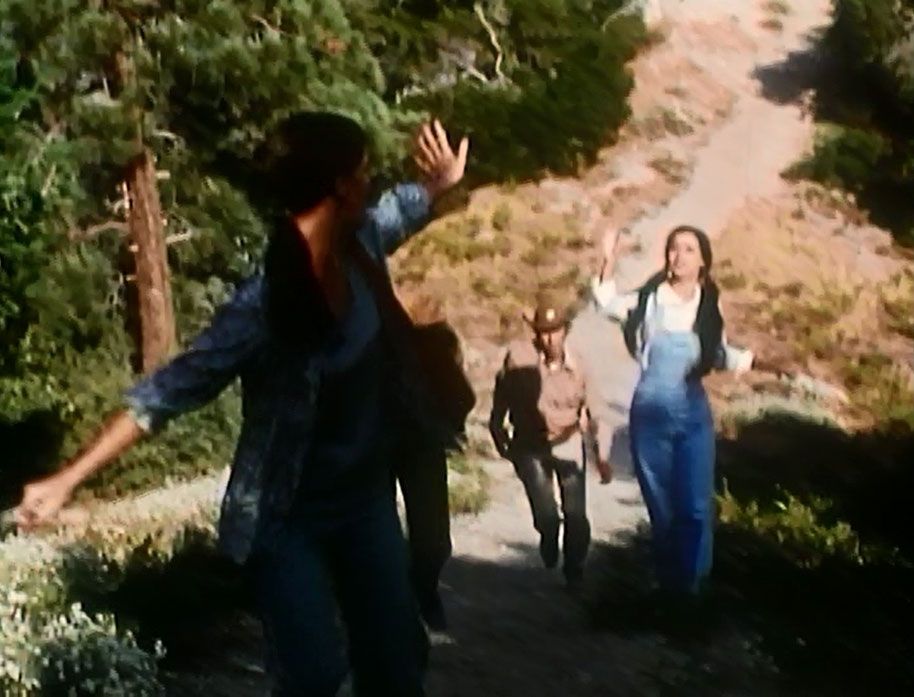 |
| Cindy Lee remembers her camera is still in the car... |
 |
| The mysterious lights over the mountain. |
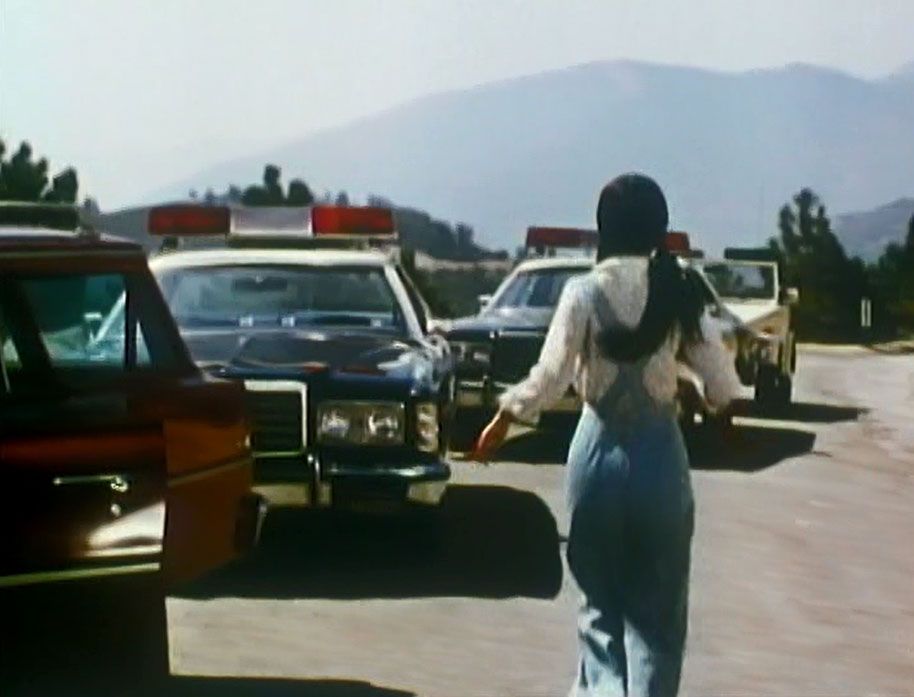 |
| Gotta snap some photos! |
 |
| Oh no! I'm out of film! |
 |
| The frightening alien tones continue. |
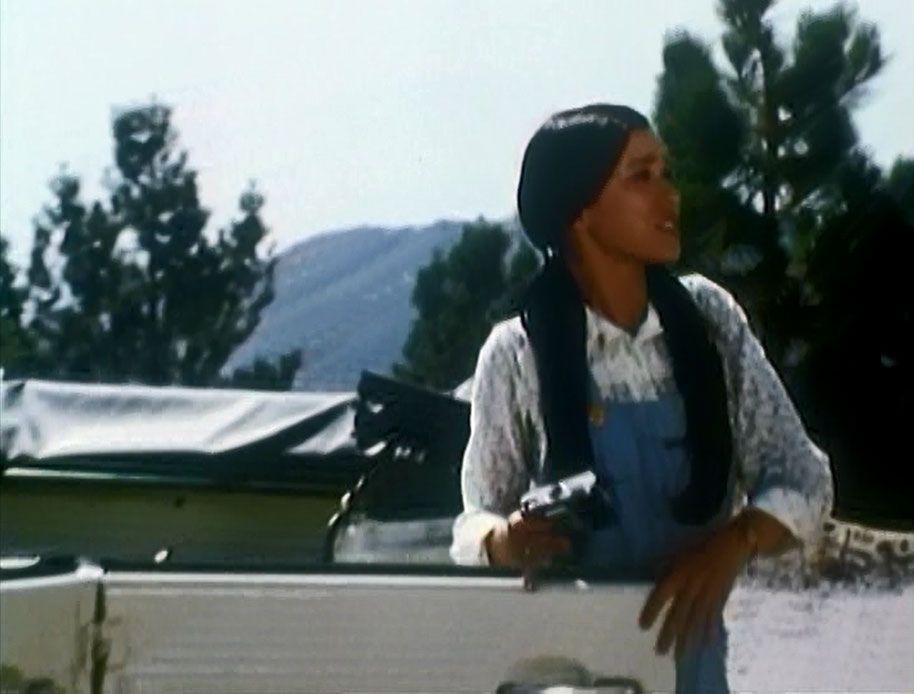 |
| Ms. Thomas! Mr. Mason! Where are you? |
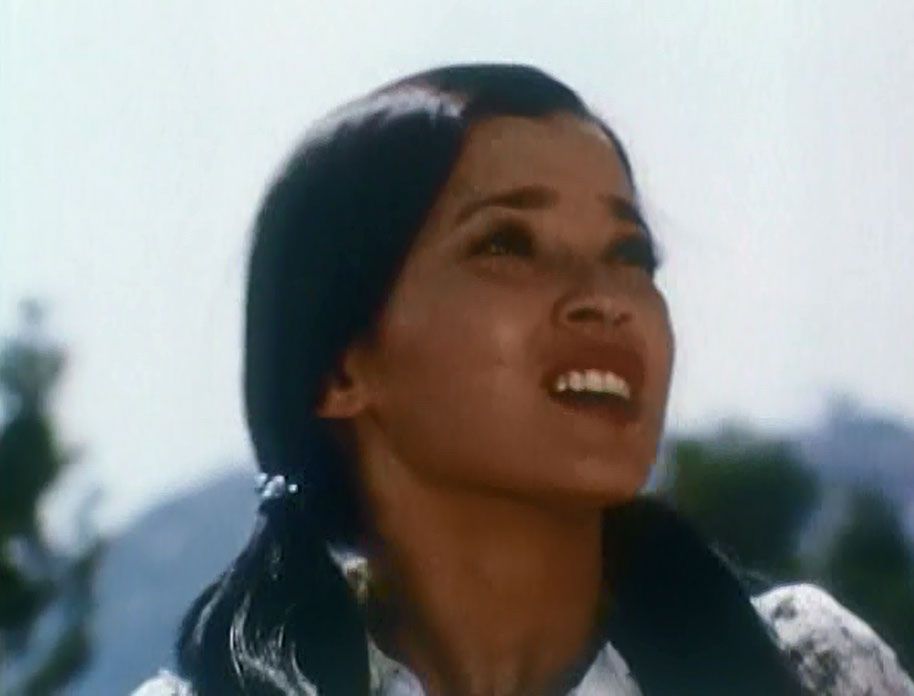 |
| I need you! |
A few moments later and Thomas and Mason sense something amiss. They parked the cars only a few yards away. Cindy should have returned by now. The teachers clamber down the mountain trail after her only to find...
No one. No Cindy Lee. A moment later, Thomas comes across this...
It's just like the burned spots found at sites where the campers and tourist disappeared. Have bizarre, inhuman beings from another world spirited Cindy Lee away? Kind of...
It looks as if this is a job for...
Isis eventually presents a prosaic explanation for all these strange happenings, but not before our favorite goddess swoops to the rescue and uses her magic to give a mean old real estate baron a fright of his own. Of course, one might expect a universe that allows for the existence of magic and ancient Egyptian goddesses living dual lives entwined with 20th century pedagogues to also allow for the existence of life on other planets, and to posit this life as a regular, if secretive, visitor to our own humble world. Indeed, Isis does leave open this very possibility even while suggesting what we must chiefly concern ourselves with are terrestrial threats-- corrupt old men who would employ fun-loving pranksters to help them achieve nefarious goals. And scare nice kids like Cindy Lee.
Tuesday, October 15, 2013
October is Spookey Month: Tomb of Dracula #7 introduces Edith Harker
We all know how Quincy Harker's daughter Edith meets her doom-- staked by her own father in Tomb of Dracula #12, "Night of the Screaming House" (September 1973). But how did she find her way into the pages of Tomb of Dracula in the first place? It happens in #7 (March 1973) "Night of the Death Stalkers," (lotta "nights" going on here) with her father making his debut a page or two later.
Let's look at the cover before we get into the story. Doesn't Dracula have a fun sense of humor here? This is some clever copy and it hooks me immediately. The drawing is by Larry Lieber, Stan Lee's little brother. It gives readers a fairly accurate depiction of the story inside. It's not nearly as dynamic as some of the series' Gil Kane covers, but Kane was one of those "gold standard" cover artists and it's not really fair to compare anyone to him. And yet I just did, didn't I? What I like about Lieber's cover, however, is he makes Dracula look a lot like Hammer Studios' own Christopher Lee, the finest of all screen Draculas (and tallest). I'm going to assume Lieber agrees with me and that in itself is more than enough to recommend this cover. I'm in favor of Gene Colan's "casting" of Jack Palance as powerhouse, intensely masculine Dracula inside the pages, but the more sinisterly refined Lee played Dracula for a longer period and emerged with dignity intact despite some increasingly silly material like Dracula, A.D. 1972 and Satanic Rites of Dracula, both of which provide prototypes for Tomb of Dracula. You know, Dracula in the modern age, tooling around London and swingin' hippies and mods and all that. So Lee is also very appropriate. Anyway, the cover does its job competently if not spectacularly, but it's still fun. The issue preceding this one had a Neal Adams cover, by the way!
Take a deep breath, because here... we... go...
In this issue, Rachel van Helsing introduces her pal Frank Drake to the Harkers and they form a vampire-fighting association the likes of which the world had never seen. Well, not really. It's a group similar to the one Bram Stoker came up with in his original novel, the one that started this whole Dracula business. I've always liked vampire-fighting groups, and Tomb of Dracula's is far and away my favorite because everyone is a bit edgy and damaged. While Marv Wolfman's core cast coalesces, their enemy, the famed count himself, self-styled Lord of the Undead, is busy making new friends of his own. Because Tomb of Dracula #7 has a lot more going for it than just the first appearance of Edith Harker and her dad. It also has one of Dracula's most sinister plans-- hypnotizing a bunch of kids into killers. Kids, killers. They both start with the letter k, and lemme tell you, there are some kids out there who would just as soon slit your throat as look at you even without a vampire master giving them hypnotic orders. Slit your throat, then enjoy delicious Honeycombs cereal as a part of any complete breakfast.
Dracula's logic for this is while Harker and company would stop at nothing to kill vampires, they're not about to murder children, not even to save their own lives. Turns out he's right.
This set-up reminds me of Village of the Damned, that truly disquieting film where time stops in a quaint village and nine months later a cadre of identical blonde babies arrive. They grow up into sinister children who delight in murder via telepathy and wearing blonde wigs. It's also reminiscent of those Simon-Kirby kid gangs of yore. The killer Boy Commandos in Tomb don't wear wigs and they don't engage in any witty repartee, but they do sport some eerie glowing eyes as they silently and relentlessly pursue our heroes. They do such a good job of it, the story stretches into Tomb of Dracula #8 (April 1973), which has a John Buscema cover.
Getting back to Edith. Since we've already covered Edith's final moments, let's take a look at her first.
I'm going to assume she works at the chemist (that's "pharmacy" or "drugstore" to us colonials) Colan draws her leaving. Gosh, it sure is cold. I hope she gets home all right...
Oops! No such luck. Yes, she is the book's jeopardy queen. Still, a bash in the face is better than a bite on the neck when you're dealing with the undead, and it's Edith Harker's good luck to have come face-to-face with the boss of them all and come away with only a bruise. Dracula seems kind of a quitter here, though, doesn't he? Edith's wearing one measly little cross. Where is Dracula's amazing hypnotic gaze to make her take it off so he can feed on her? It takes him about two seconds to enthrall those kids.
Speaking of which, here they are:
It looks as though someone at Marvel did a really clumsy art touch-up on Dracula's head in the fourth panel. The face is Colan/Palmer, but the wonky perspective on the forehead (the widow's peak is turned a few degrees from where it should be both vertically and horizontally and there's no foreshortening despite the slightly low-angle view of Dracula's head) and the hair texture look completely alien. Why? Maybe the page passed through the inking and lettering stages with the top balloon coming out too large and covering too much of Dracula. The editor decided we needed more of Dracula's head in there, which meant reducing the balloon and getting someone on staff to touch up the missing areas. Just speculating about a hypothesis, but it also looks as if someone mistook Dracula's left hand for one of the background trees and colored it brown as a result.
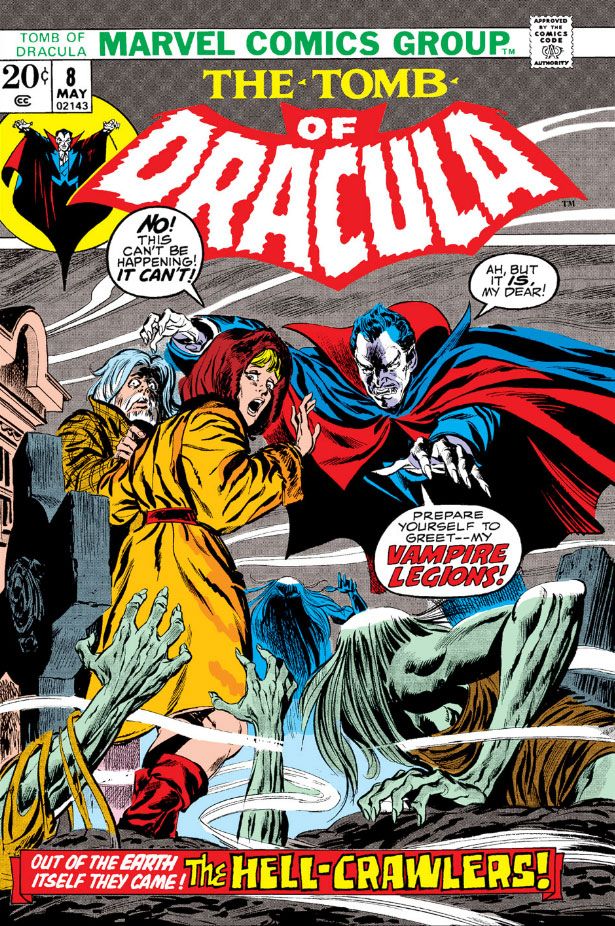 Here's one of the most disturbing aspects of vampire lore-- the corruption of innocence. Stoker used this is a major theme in his novel, and Wolfman picks up on it. In Stoker's book, Dracula's first victim is the virginal Lucy Westenra, the ideal of proper young womanhood in the Victorian Age. By the time Dracula is through with her, she's feeding on babies in a parody of nurturing motherhood. Wolfman's Dracula will stop at nothing in his quest for power or whatever he holds as his ultimate goal and a bunch of boys become his weapons. They're very effective, surprisingly so. They chase Frank and company right out into the night and trap them in an old-fashioned car and there's not a thing anyone can do about it.
Here's one of the most disturbing aspects of vampire lore-- the corruption of innocence. Stoker used this is a major theme in his novel, and Wolfman picks up on it. In Stoker's book, Dracula's first victim is the virginal Lucy Westenra, the ideal of proper young womanhood in the Victorian Age. By the time Dracula is through with her, she's feeding on babies in a parody of nurturing motherhood. Wolfman's Dracula will stop at nothing in his quest for power or whatever he holds as his ultimate goal and a bunch of boys become his weapons. They're very effective, surprisingly so. They chase Frank and company right out into the night and trap them in an old-fashioned car and there's not a thing anyone can do about it.
In fact, the hypno-kids do such a fine job of taking Dracula's enemies out of the fight, he finally has a little leisure time on his hands. The next issue (nicely inked by Ernie Chan-- credited as Chua thanks to a bureaucratic screw-up on his immigration documents) sees Dracula using this free time to recruit some even more sinister allies, a lot of moldy vampires. I think he should have stuck with kids. Imagine Dracula getting himself on TV, perhaps taking one of those horror movie host jobs, or showing up at a station where they do one locally and beaming his powers across a wider area, ensnaring hundreds, perhaps thousands, of children and turning them against the adults. Kind of like Halloween 3, but without that Silver Shamrock rhyme to get into your mind and stay. And stay. AND STAY.
And here's where it turns out I owe Edith Harker something of an apology. She first appears as a typical damsel in distress, and goes out that way as well. But she gets to come to the rescue herself at least once before Dracula and dear old dad put an end to her once and for all.
And here she is:
You go, Edith! Sorry they didn't get your hair color right in this, your shining moment.
Let's look at the cover before we get into the story. Doesn't Dracula have a fun sense of humor here? This is some clever copy and it hooks me immediately. The drawing is by Larry Lieber, Stan Lee's little brother. It gives readers a fairly accurate depiction of the story inside. It's not nearly as dynamic as some of the series' Gil Kane covers, but Kane was one of those "gold standard" cover artists and it's not really fair to compare anyone to him. And yet I just did, didn't I? What I like about Lieber's cover, however, is he makes Dracula look a lot like Hammer Studios' own Christopher Lee, the finest of all screen Draculas (and tallest). I'm going to assume Lieber agrees with me and that in itself is more than enough to recommend this cover. I'm in favor of Gene Colan's "casting" of Jack Palance as powerhouse, intensely masculine Dracula inside the pages, but the more sinisterly refined Lee played Dracula for a longer period and emerged with dignity intact despite some increasingly silly material like Dracula, A.D. 1972 and Satanic Rites of Dracula, both of which provide prototypes for Tomb of Dracula. You know, Dracula in the modern age, tooling around London and swingin' hippies and mods and all that. So Lee is also very appropriate. Anyway, the cover does its job competently if not spectacularly, but it's still fun. The issue preceding this one had a Neal Adams cover, by the way!
Take a deep breath, because here... we... go...
In this issue, Rachel van Helsing introduces her pal Frank Drake to the Harkers and they form a vampire-fighting association the likes of which the world had never seen. Well, not really. It's a group similar to the one Bram Stoker came up with in his original novel, the one that started this whole Dracula business. I've always liked vampire-fighting groups, and Tomb of Dracula's is far and away my favorite because everyone is a bit edgy and damaged. While Marv Wolfman's core cast coalesces, their enemy, the famed count himself, self-styled Lord of the Undead, is busy making new friends of his own. Because Tomb of Dracula #7 has a lot more going for it than just the first appearance of Edith Harker and her dad. It also has one of Dracula's most sinister plans-- hypnotizing a bunch of kids into killers. Kids, killers. They both start with the letter k, and lemme tell you, there are some kids out there who would just as soon slit your throat as look at you even without a vampire master giving them hypnotic orders. Slit your throat, then enjoy delicious Honeycombs cereal as a part of any complete breakfast.
Dracula's logic for this is while Harker and company would stop at nothing to kill vampires, they're not about to murder children, not even to save their own lives. Turns out he's right.
This set-up reminds me of Village of the Damned, that truly disquieting film where time stops in a quaint village and nine months later a cadre of identical blonde babies arrive. They grow up into sinister children who delight in murder via telepathy and wearing blonde wigs. It's also reminiscent of those Simon-Kirby kid gangs of yore. The killer Boy Commandos in Tomb don't wear wigs and they don't engage in any witty repartee, but they do sport some eerie glowing eyes as they silently and relentlessly pursue our heroes. They do such a good job of it, the story stretches into Tomb of Dracula #8 (April 1973), which has a John Buscema cover.
Getting back to Edith. Since we've already covered Edith's final moments, let's take a look at her first.
I'm going to assume she works at the chemist (that's "pharmacy" or "drugstore" to us colonials) Colan draws her leaving. Gosh, it sure is cold. I hope she gets home all right...
Oops! No such luck. Yes, she is the book's jeopardy queen. Still, a bash in the face is better than a bite on the neck when you're dealing with the undead, and it's Edith Harker's good luck to have come face-to-face with the boss of them all and come away with only a bruise. Dracula seems kind of a quitter here, though, doesn't he? Edith's wearing one measly little cross. Where is Dracula's amazing hypnotic gaze to make her take it off so he can feed on her? It takes him about two seconds to enthrall those kids.
Speaking of which, here they are:
It looks as though someone at Marvel did a really clumsy art touch-up on Dracula's head in the fourth panel. The face is Colan/Palmer, but the wonky perspective on the forehead (the widow's peak is turned a few degrees from where it should be both vertically and horizontally and there's no foreshortening despite the slightly low-angle view of Dracula's head) and the hair texture look completely alien. Why? Maybe the page passed through the inking and lettering stages with the top balloon coming out too large and covering too much of Dracula. The editor decided we needed more of Dracula's head in there, which meant reducing the balloon and getting someone on staff to touch up the missing areas. Just speculating about a hypothesis, but it also looks as if someone mistook Dracula's left hand for one of the background trees and colored it brown as a result.
 Here's one of the most disturbing aspects of vampire lore-- the corruption of innocence. Stoker used this is a major theme in his novel, and Wolfman picks up on it. In Stoker's book, Dracula's first victim is the virginal Lucy Westenra, the ideal of proper young womanhood in the Victorian Age. By the time Dracula is through with her, she's feeding on babies in a parody of nurturing motherhood. Wolfman's Dracula will stop at nothing in his quest for power or whatever he holds as his ultimate goal and a bunch of boys become his weapons. They're very effective, surprisingly so. They chase Frank and company right out into the night and trap them in an old-fashioned car and there's not a thing anyone can do about it.
Here's one of the most disturbing aspects of vampire lore-- the corruption of innocence. Stoker used this is a major theme in his novel, and Wolfman picks up on it. In Stoker's book, Dracula's first victim is the virginal Lucy Westenra, the ideal of proper young womanhood in the Victorian Age. By the time Dracula is through with her, she's feeding on babies in a parody of nurturing motherhood. Wolfman's Dracula will stop at nothing in his quest for power or whatever he holds as his ultimate goal and a bunch of boys become his weapons. They're very effective, surprisingly so. They chase Frank and company right out into the night and trap them in an old-fashioned car and there's not a thing anyone can do about it.In fact, the hypno-kids do such a fine job of taking Dracula's enemies out of the fight, he finally has a little leisure time on his hands. The next issue (nicely inked by Ernie Chan-- credited as Chua thanks to a bureaucratic screw-up on his immigration documents) sees Dracula using this free time to recruit some even more sinister allies, a lot of moldy vampires. I think he should have stuck with kids. Imagine Dracula getting himself on TV, perhaps taking one of those horror movie host jobs, or showing up at a station where they do one locally and beaming his powers across a wider area, ensnaring hundreds, perhaps thousands, of children and turning them against the adults. Kind of like Halloween 3, but without that Silver Shamrock rhyme to get into your mind and stay. And stay. AND STAY.
And here's where it turns out I owe Edith Harker something of an apology. She first appears as a typical damsel in distress, and goes out that way as well. But she gets to come to the rescue herself at least once before Dracula and dear old dad put an end to her once and for all.
And here she is:
You go, Edith! Sorry they didn't get your hair color right in this, your shining moment.
Sunday, October 13, 2013
October is Spookey Month: Star Trek #19 in which a space criminal is frightened into incontinence...
The original Star Trek series sometimes combined science fiction with straight up horror, maybe softened a bit by a little dialogue about an "energy source" that creates whatever magic Kirk, Spock and the rest come up against. But the idea was still using the old cliches to fill fifty minutes worth of story without being so obvious about it. The very first episode to air, "The Man Trap" (September 8, 1966), featured a "salt vampire" that was pretty much just a version of a regular vampire story dressed up a little for a futuristic setting. The crew met a witch in "Catspaw," written by Psycho author and H.P. Lovecraft protege Robert Bloch. It ran just in time for Halloween (October 27, 1967, to be exact) and came complete with a black cat and a gothic castle. And let's not forget "Wolf in the Fold" (December 22 the same year), also written by Bloch. That's the one where we find out Jack the Ripper was possessed by some kind of immortal, incorporeal entity that feeds on fear. When it gets into the ship's computer and starts screaming "RED JACK! RED JACK!" over the intercom, Trek for the first time managed to scare me silly. Even reading the James Blish short story adaptation of that particular episode frequently gave me the willies, the heebiejeebies, the whimwhams or small pox.
The Gold Key Star Trek comic adds ghosts to the mix in #19 (July 1973) , where (according to Comixology at least) writer Len Wein-- of all new, all different X-Men and Swamp Thing fame-- presents our daring space explorers with a supposedly haunted asteroid where something fearful dwells. How fearful? So fearful that after encountering it, this poor guy reverts to childhood and has to wear diapers for the rest of his life:
Because Starfleet favors the empirical over the metaphysical, the Enterprise warps to the asteroid for an investigation. Kirk's old Academy pal Jay Nordyke goes down and comes back with selective amnesia. Hypnotic regression reveals he's erased from his memory a horrifying encounter with a ghost. At least he can still function as an adult. Kirk, Spock, Sulu and some others beam down to check things out and gamble they're mentally tough enough to stay grown ups and in control of their bowels no matter what they face.
Aiding the ghostbusting is Dr. Krisp (first name Cookie) who, despite wearing a smart black skirt, proves a bit shaky in the field. She and Kirk get down... to business (get your mind out of the gutter, please) and solve the mystery. It turns out it's more science than supernatural, a variation on the old Scooby Doo, Where Are You? ploy of someone pretending to be a ghost to frighten people away when we all know that would only attract hordes of macho jackasses with night vision video cameras and heat signature detectors and a whole lot of pseudo-scientific bullshit to run around shouting at the walls for SyFy.
By borrowing heavily from the story of the Taj Mahal, Wein does a sweet job of setting up and then explaining the mystery. There are some characteristically goofy moments because it's Gold Key, like hardened space travelers trained in scientific observation screaming "zombies" when what they're looking at is patently something else with which they should be very familiar given the Federation's technology. And I love Alberto Giolitti's off-model artwork. He sometimes all too obviously uses photo reference for some portrait-style panels, but most of the time it just seems like he had only the vaguest idea about the property he was working on. As a result, a few things have been lost in translation, but a lot of charm has been gained. Giolitti's art has its own Giolittian flavor, kind of fusion cuisine, some Trek, a side of Flash Gordon, a liberal dollop of European comics. In the end, it proves a deliciously satisfying yet wild stew of different ingredients. The exterior of the mausoleum looks Mughal, the interior gothic, the costumes strictly Ancient Egyptian. At the same time, that's not too far from what the show itself used to do, where the set and costume designers seemed to lean on whatever was available in the prop and wardrobe departments at Desilu.
The ultimate solution is a surprise, but it fits the evidence and it's also made of stuff that's very familiar to Trek fans, so we'll accept it. Or not. That is to say, I'm fine with it but you'll have to make up your own mind. This sets up a more traditional Star Trek dilemma where the crew now knows exactly what it's up against but still has to figure out how to escape an overwhelming power. It helps that Sulu reveals himself to be a champion gymnast and Scotty a champion weightlifter. I've always considered myself a solid Trekker, but I can't for the life of me remember either man possessing those skill sets. I know Sulu is an expert fencer and botanist, and that Scotty can drink anyone under the table be it Klingon or godlike evolutionarily advanced super-being. Neither of those apply here.
And what is it Kirk is good at, better than any other man?
Being a hard ass.
The Gold Key Star Trek comic adds ghosts to the mix in #19 (July 1973) , where (according to Comixology at least) writer Len Wein-- of all new, all different X-Men and Swamp Thing fame-- presents our daring space explorers with a supposedly haunted asteroid where something fearful dwells. How fearful? So fearful that after encountering it, this poor guy reverts to childhood and has to wear diapers for the rest of his life:
Because Starfleet favors the empirical over the metaphysical, the Enterprise warps to the asteroid for an investigation. Kirk's old Academy pal Jay Nordyke goes down and comes back with selective amnesia. Hypnotic regression reveals he's erased from his memory a horrifying encounter with a ghost. At least he can still function as an adult. Kirk, Spock, Sulu and some others beam down to check things out and gamble they're mentally tough enough to stay grown ups and in control of their bowels no matter what they face.
Aiding the ghostbusting is Dr. Krisp (first name Cookie) who, despite wearing a smart black skirt, proves a bit shaky in the field. She and Kirk get down... to business (get your mind out of the gutter, please) and solve the mystery. It turns out it's more science than supernatural, a variation on the old Scooby Doo, Where Are You? ploy of someone pretending to be a ghost to frighten people away when we all know that would only attract hordes of macho jackasses with night vision video cameras and heat signature detectors and a whole lot of pseudo-scientific bullshit to run around shouting at the walls for SyFy.
By borrowing heavily from the story of the Taj Mahal, Wein does a sweet job of setting up and then explaining the mystery. There are some characteristically goofy moments because it's Gold Key, like hardened space travelers trained in scientific observation screaming "zombies" when what they're looking at is patently something else with which they should be very familiar given the Federation's technology. And I love Alberto Giolitti's off-model artwork. He sometimes all too obviously uses photo reference for some portrait-style panels, but most of the time it just seems like he had only the vaguest idea about the property he was working on. As a result, a few things have been lost in translation, but a lot of charm has been gained. Giolitti's art has its own Giolittian flavor, kind of fusion cuisine, some Trek, a side of Flash Gordon, a liberal dollop of European comics. In the end, it proves a deliciously satisfying yet wild stew of different ingredients. The exterior of the mausoleum looks Mughal, the interior gothic, the costumes strictly Ancient Egyptian. At the same time, that's not too far from what the show itself used to do, where the set and costume designers seemed to lean on whatever was available in the prop and wardrobe departments at Desilu.
The ultimate solution is a surprise, but it fits the evidence and it's also made of stuff that's very familiar to Trek fans, so we'll accept it. Or not. That is to say, I'm fine with it but you'll have to make up your own mind. This sets up a more traditional Star Trek dilemma where the crew now knows exactly what it's up against but still has to figure out how to escape an overwhelming power. It helps that Sulu reveals himself to be a champion gymnast and Scotty a champion weightlifter. I've always considered myself a solid Trekker, but I can't for the life of me remember either man possessing those skill sets. I know Sulu is an expert fencer and botanist, and that Scotty can drink anyone under the table be it Klingon or godlike evolutionarily advanced super-being. Neither of those apply here.
And what is it Kirk is good at, better than any other man?
Being a hard ass.
Labels:
Alberto Giolitti,
Gold Key,
good comics,
Halloween,
horror,
Len Wein,
Spookey,
Star Trek,
vintage comics
Friday, October 11, 2013
October is Spookey Month: And now a Spookey video!
As you know, Spookey is from my adopted hometown here in Japan and inspired this annual month-long Halloween celebration They're a lot better than my overwrought prose, right?
October is Spookey Month: Tomb of Dracula #12 teaches us most accidents happen at home
Is it controversial to say Tomb of Dracula was Marvel's best comic of the 1970s? It has some strong competition from Conan the Barbarian where Barry Windsor-Smith displayed exponential artistic growth; from X-Men/The Uncanny X-Men with Chris Claremont, Dave Cockrum and then John Byrne creating a mythos that won all those Eagle Awards and underpins the entire Marvel universe to this day; and from Howard the Duck where Steve Gerber and artists like Frank Brunner, Val Mayerik and Gene Colan inspired Marvel's first movie adaptation (an infamously lousy one, but still a big budget, George Lucas-produced film released to theaters in the belief it would be a big hit).
Those are all fine series, and I've enjoyed each of them. But Tomb is just something else entirely. Tomb is like wow times wowee for a little "wowee-wow-wow." Tomb took an exhausted public domain property-- good ol' Count Dracula, star of dozens of movies, TV shows and comic books in one form or another-- and gave it a compelling, new un-life. Writer Marv Wolfman's melodramatic prose perfectly matches Gene Colan's shadowy visuals, the two elements working in tandem like peanut butter and chocolate in a Reese's. When Marvel finally teamed Colan with inker Tom Palmer, the two produced what I will argue was consistently the most breathtakingly beautiful color monthly of the entire decade.
Operating on the fringes of the Marvel universe, Tomb functions as a sequel and expansion of Bram Stoker's novel. In fact, lead good guy Frank Drake is a descendant of Dracula himself, his last name an Americanized version of the original. Quincy Harker comes right out of the original book, the first born child of Jonathan and Mina (nee Murray) Harker, conceived and born after the novel's main events and named after one of Dracula's victims, the Harkers' courageous American cowboy friend Quincy Morris. Wolfman casts Harker in the Dr. Van Helsing role. More troubled than his Stokerian prototype, Harker rides around in a weaponized wheelchair the likes of which James Bond's pal Q would envy, and he uses it to save himself and others several times throughout the stories. His hardboiled protégé (and later, Drake's lover), Rachel van Helsing, is the grand-daughter of the Stoker character. Both Taj Nital, devoted companion to Rachel, and-- most significantly-- Blade, the ultra-cool, Blaxploitation-style member of the group, are wholly original. At least I don't remember Stoker having watched Shaft, Super Fly or Hammer, but he could very well have despite having died about 60 years before the birth of the film genre.
Every October, I turn to Tomb of Dracula and it helps put me in that spooky, haunted Halloween mood. It has its funky idiosyncrasies-- too many scenes where Rachel, Frank and Blade confront Dracula and all they do is trade arch insults and a whole lotta plots where Dracula almost dies, only to escape at the last moment. After all, how many times can our vamp-slaying crew almost destroy Dracula before they start to seem completely incompetent to the point they lose our sympathies and incur our scorn, like that bumbling Gilligan? Tomb of Dracula ends rather abruptly with issue #70 before it has a chance to devolve into self-parody, but even when things turn silly as they occasionally do, the overall atmosphere remains one of effectively updated gothic horror, and there are still plenty of genuinely creepy moments to restore our faith. Which finally brings us to tonight's topic, Tomb of Dracula #12 (September 1973) and a little story we like to call "Night of the Screaming House." Because that's what Marv Wolfman named it.
Oh, on the Frank Brunner-illustrated cover, Dracula calls it the "House that Screams," but you should never believe anything the king of the vampires tells you. He has his own agenda and will lie when it suits him.
Okay, forget Dracula before... er... remembering him again. Because Wolfman and Colan throw us right into the action with the main characters locked in a ferocious show-down with none other than Dracula, who has caught himself a delicious dinner, but can't catch a moment to eat in peace. It's not a holdover from a cliffhanger ending to the previous issue (in which Dracula fought some motorcycle guys who aren't quite as menacing as the Sons of Anarchy bunch, although they do their best). It's more like, "Open the book, here we are!"
Unfortunately one of them, Harker's daughter Edith, is ill-equipped for the life of a fearless vampire hunter. Edith Harker was simply born to find herself in jeopardy. Wolfman and Colan introduce her to the series that way in Tomb #7 (March 1973), and in "Screaming House" (as its friends call it; the rest of you must refer to it in full, with an honorific of your choice), she really finds herself in a mess, the likes of which no heart-felt talk with Sheriff Andy Taylor, Mrs. Garret or Mr. Belvedere can solve. After a lot of posturing on both sides and some ineffectual hand-to-hand, Dracula spirits Edith away to a shabby old house so he can toy with his adversaries rather than just kill them outright.
With his mastery of vertigo-inducing camera angles, Colan expertly depicts the abduction, which is quite alarming as Dracula transforms only partially into his bat-form. This emphasizes his otherworldly aspects by making him a grotesque hybrid creature, plus it gives him enough strength to carry Edith through the air. He needs those membranous arm-wings to do two things at once.
And the titular screaming house is foe unto itself. It's full of rotten floorboards that give way at inopportune times and Dracula's hidden away traps of his own, like the black widow cages he slips around the corner beneath Frank Drake's feet at one point. The good guys split up to cover more ground and render themselves even less effective against Dracula and it all comes to a tragic conclusion.
While the story itself is pretty straightforward, at least compared to later issues (which would feature adversaries such as a Communist Chinese brain in an aquarium, Dracula's hated vampire daughter, a faceless dead man and, later, his own weirdo son, an angelic/demonic pretty boy calling himself Janus) it has some important character development.
Once he plunges his cast into Dracula's fun house, Wolfman depicts Drake as scared almost out of his wits to the point of stuttering as he speaks. And yet the guy still pushes on alone. While Drake is in a state of transition from callow rich jerk to bumbling vampire avenger to intrepid daredevil hero, it helps reinforce the danger Dracula personifies. Remember, when you go against a vampire it's not just your life that's in hazard; it's your very soul. And with Dracula the series anti-hero, there's always the chance over-familiarity with the character and his motivations will weaken his menace and turn him into just another ineffective Marvel villain fond of soliloquys in the dark. This is especially true if the characters in the book come to view him as ho-hum.
Another important character point is the scarring of Rachel's face. Bats, released by Dracula, attack the group and Rachel gets a makeover. These scars become part of her character and eventually symbolize the hardening of her spirit. So important are these scars, when Wolfman and Colan resurrect Rachel years later in their Tomb of Dracula miniseries, it's through a kind of possession that involves a brand-new character tearing at her own face until she resembles Rachel and loses her own identity.
The final and most poignant element is Edith's fate and the matter-of-fact way Quincy deals with it. While Frank reacts with very human but misguided compassion and hopefulness, Quincy Harker knows from experience there is only one thing to do. Wolfman could easily cop out at this point and offer a last-minute reprieve in the form of some never-before-heard-of cure, but no. Instead, he sacrifices a character to the betterment of the story. It's a moment reminiscent of the scene from Stephen King's 1976 novel 'Salem's Lot where protagonist Ben Mears is forced to drive a stake through Susan Norton's (his vampirized girlfriend) heart. King changes viewpoint characters throughout his story, spending a great deal of time and care making readers empathize with Susan by allowing them to see events from her perspective. Her loss in the narrative gains impact because we think of her loss as tragic unto itself rather than merely something that incites Ben's actions towards the climax.
Wolfman hasn't had enough time to do as much for Edith. Because her fictional career ends so abruptly, she remains something of a punching bag of a character. And yet, Harker's coldly pragmatic method of dealing with her is chilling. This is what separates a true horror story from an adventure that uses horror trappings. Horror forces characters into painful choices, the loss of sanity, of limbs, of life, of loved ones.
Those are all fine series, and I've enjoyed each of them. But Tomb is just something else entirely. Tomb is like wow times wowee for a little "wowee-wow-wow." Tomb took an exhausted public domain property-- good ol' Count Dracula, star of dozens of movies, TV shows and comic books in one form or another-- and gave it a compelling, new un-life. Writer Marv Wolfman's melodramatic prose perfectly matches Gene Colan's shadowy visuals, the two elements working in tandem like peanut butter and chocolate in a Reese's. When Marvel finally teamed Colan with inker Tom Palmer, the two produced what I will argue was consistently the most breathtakingly beautiful color monthly of the entire decade.
Operating on the fringes of the Marvel universe, Tomb functions as a sequel and expansion of Bram Stoker's novel. In fact, lead good guy Frank Drake is a descendant of Dracula himself, his last name an Americanized version of the original. Quincy Harker comes right out of the original book, the first born child of Jonathan and Mina (nee Murray) Harker, conceived and born after the novel's main events and named after one of Dracula's victims, the Harkers' courageous American cowboy friend Quincy Morris. Wolfman casts Harker in the Dr. Van Helsing role. More troubled than his Stokerian prototype, Harker rides around in a weaponized wheelchair the likes of which James Bond's pal Q would envy, and he uses it to save himself and others several times throughout the stories. His hardboiled protégé (and later, Drake's lover), Rachel van Helsing, is the grand-daughter of the Stoker character. Both Taj Nital, devoted companion to Rachel, and-- most significantly-- Blade, the ultra-cool, Blaxploitation-style member of the group, are wholly original. At least I don't remember Stoker having watched Shaft, Super Fly or Hammer, but he could very well have despite having died about 60 years before the birth of the film genre.
Every October, I turn to Tomb of Dracula and it helps put me in that spooky, haunted Halloween mood. It has its funky idiosyncrasies-- too many scenes where Rachel, Frank and Blade confront Dracula and all they do is trade arch insults and a whole lotta plots where Dracula almost dies, only to escape at the last moment. After all, how many times can our vamp-slaying crew almost destroy Dracula before they start to seem completely incompetent to the point they lose our sympathies and incur our scorn, like that bumbling Gilligan? Tomb of Dracula ends rather abruptly with issue #70 before it has a chance to devolve into self-parody, but even when things turn silly as they occasionally do, the overall atmosphere remains one of effectively updated gothic horror, and there are still plenty of genuinely creepy moments to restore our faith. Which finally brings us to tonight's topic, Tomb of Dracula #12 (September 1973) and a little story we like to call "Night of the Screaming House." Because that's what Marv Wolfman named it.
Oh, on the Frank Brunner-illustrated cover, Dracula calls it the "House that Screams," but you should never believe anything the king of the vampires tells you. He has his own agenda and will lie when it suits him.
Okay, forget Dracula before... er... remembering him again. Because Wolfman and Colan throw us right into the action with the main characters locked in a ferocious show-down with none other than Dracula, who has caught himself a delicious dinner, but can't catch a moment to eat in peace. It's not a holdover from a cliffhanger ending to the previous issue (in which Dracula fought some motorcycle guys who aren't quite as menacing as the Sons of Anarchy bunch, although they do their best). It's more like, "Open the book, here we are!"
Unfortunately one of them, Harker's daughter Edith, is ill-equipped for the life of a fearless vampire hunter. Edith Harker was simply born to find herself in jeopardy. Wolfman and Colan introduce her to the series that way in Tomb #7 (March 1973), and in "Screaming House" (as its friends call it; the rest of you must refer to it in full, with an honorific of your choice), she really finds herself in a mess, the likes of which no heart-felt talk with Sheriff Andy Taylor, Mrs. Garret or Mr. Belvedere can solve. After a lot of posturing on both sides and some ineffectual hand-to-hand, Dracula spirits Edith away to a shabby old house so he can toy with his adversaries rather than just kill them outright.
With his mastery of vertigo-inducing camera angles, Colan expertly depicts the abduction, which is quite alarming as Dracula transforms only partially into his bat-form. This emphasizes his otherworldly aspects by making him a grotesque hybrid creature, plus it gives him enough strength to carry Edith through the air. He needs those membranous arm-wings to do two things at once.
And the titular screaming house is foe unto itself. It's full of rotten floorboards that give way at inopportune times and Dracula's hidden away traps of his own, like the black widow cages he slips around the corner beneath Frank Drake's feet at one point. The good guys split up to cover more ground and render themselves even less effective against Dracula and it all comes to a tragic conclusion.
While the story itself is pretty straightforward, at least compared to later issues (which would feature adversaries such as a Communist Chinese brain in an aquarium, Dracula's hated vampire daughter, a faceless dead man and, later, his own weirdo son, an angelic/demonic pretty boy calling himself Janus) it has some important character development.
Once he plunges his cast into Dracula's fun house, Wolfman depicts Drake as scared almost out of his wits to the point of stuttering as he speaks. And yet the guy still pushes on alone. While Drake is in a state of transition from callow rich jerk to bumbling vampire avenger to intrepid daredevil hero, it helps reinforce the danger Dracula personifies. Remember, when you go against a vampire it's not just your life that's in hazard; it's your very soul. And with Dracula the series anti-hero, there's always the chance over-familiarity with the character and his motivations will weaken his menace and turn him into just another ineffective Marvel villain fond of soliloquys in the dark. This is especially true if the characters in the book come to view him as ho-hum.
Another important character point is the scarring of Rachel's face. Bats, released by Dracula, attack the group and Rachel gets a makeover. These scars become part of her character and eventually symbolize the hardening of her spirit. So important are these scars, when Wolfman and Colan resurrect Rachel years later in their Tomb of Dracula miniseries, it's through a kind of possession that involves a brand-new character tearing at her own face until she resembles Rachel and loses her own identity.
The final and most poignant element is Edith's fate and the matter-of-fact way Quincy deals with it. While Frank reacts with very human but misguided compassion and hopefulness, Quincy Harker knows from experience there is only one thing to do. Wolfman could easily cop out at this point and offer a last-minute reprieve in the form of some never-before-heard-of cure, but no. Instead, he sacrifices a character to the betterment of the story. It's a moment reminiscent of the scene from Stephen King's 1976 novel 'Salem's Lot where protagonist Ben Mears is forced to drive a stake through Susan Norton's (his vampirized girlfriend) heart. King changes viewpoint characters throughout his story, spending a great deal of time and care making readers empathize with Susan by allowing them to see events from her perspective. Her loss in the narrative gains impact because we think of her loss as tragic unto itself rather than merely something that incites Ben's actions towards the climax.
Wolfman hasn't had enough time to do as much for Edith. Because her fictional career ends so abruptly, she remains something of a punching bag of a character. And yet, Harker's coldly pragmatic method of dealing with her is chilling. This is what separates a true horror story from an adventure that uses horror trappings. Horror forces characters into painful choices, the loss of sanity, of limbs, of life, of loved ones.
Subscribe to:
Posts (Atom)

